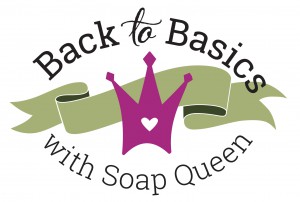
When starting to make cold process soap, it can be tempting to take the “go big, or go home,” approach. New soapers often want to dive in head first with layers, swirls and fragrances. While I completely understand the urge to make eye-catching soap, I always recommend starting with very basic recipe. A great place to start is a recipe that includes no colorants, design, or fragrance. I also highly recommend sticking to the three most basic soaping oils: olive, coconut and palm.
This might sound a little boring to some, but there is a lot to learn when making your first batch of cold process soap. First, you need to learn how to safely mix your lye solution. Then, you need to correctly mix and measure your soap making oils. Sometimes pouring the lye into your oils while holding your stick blender can feel a little funny, and your first batch of soap familiarizes you with this. Your first batch also teaches you what trace looks and “feels” like. In addition, you may need to line your mold.
All of this combined is plenty when just starting out! Don’t overload yourself. I have watched many beginner soapers become discouraged right off the bat, because they attempt techniques that even advanced soapers struggle with. Set yourself up for success, and keep it simple. Trust me =)
This tutorial is the first in the Back to Basics Cold Process Series. This series of tutorials includes four cold process recipes that are perfect for beginning soapers. The Back to Basics Soapmaking Kit includes all the soaping ingredients you need to create all four recipes, including the 10″ Silicone Mold. It’s also 35% off until July 31st! The only ingredient you need to buy separately is lye, and any tools you may need. A great way to receive the basic soaping tools is with the Beginner’s Soaping Tool Kit, or click the “Buy it Now” button for the tools necessary for this project, lye and kit to your cart to your cart separately.

Click here to add everything you need for this project to your Bramble Berry shopping cart!
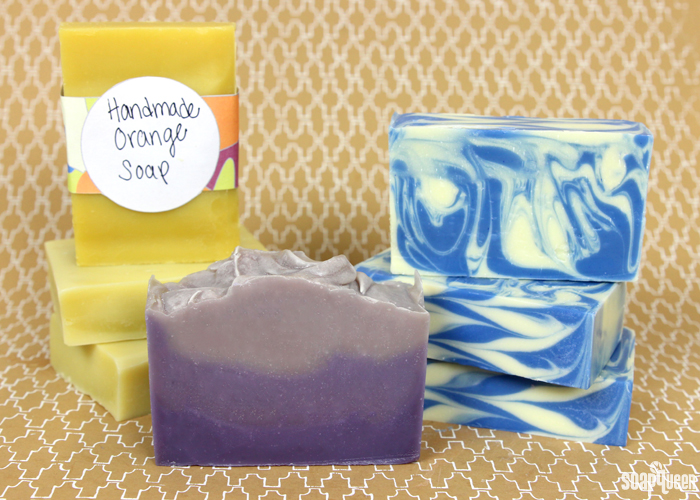 This project was designed for somebody who has never made cold process soap before. The recipe includes the three most common soaping oils, olive, palm and coconut. No colorants or fragrances are added. In addition, you can use almost any box or container that you may have on hand for your mold. We used a Medium Flat Rate Box from the USPS. This size created perfect thin bars that are easy to hold and use. Now, before we get started, let’s go over a few basic soaping terms. These words come up quite a bit in Soap Queen tutorials, and it’s helpful to have a solid grasp on them before moving forward with soap making.
This project was designed for somebody who has never made cold process soap before. The recipe includes the three most common soaping oils, olive, palm and coconut. No colorants or fragrances are added. In addition, you can use almost any box or container that you may have on hand for your mold. We used a Medium Flat Rate Box from the USPS. This size created perfect thin bars that are easy to hold and use. Now, before we get started, let’s go over a few basic soaping terms. These words come up quite a bit in Soap Queen tutorials, and it’s helpful to have a solid grasp on them before moving forward with soap making.
Basic Cold Process Soap Terms
Saponification: Saponification refers to the chemical reaction that occurs when oil and lye molecules create new soap molecules.
Trace: Trace is a point in the soap making process when oils and lye water have emulsified and begins to thicken. Once the soap has reached thin trace, it will continue to thicken over time. Click here to read more about trace, including what thin, medium and thick trace looks like.
Emulsification/Emulsify: Emulsification is when the oils and lye solution have mixed together, and will not separate from each other. The term emulsify and trace are often used interchangeably.
Superfat: Soap is made by lye turning oil molecules into soap molecules. Any extra oil left in the soap and not attacked by the lye is called a ‘superfat.’ The terms ‘superfat’ and ‘lye discount’ can be used interchangeably. Click here to learn more about the term super fat.
Gel Phase: ‘Gelling’ and ‘gel phasing’ in cold process soap refers to a part of the saponification (soapmaking) process where the soap gets warm and gelatinous – up to 180 degrees. Gel phase results in brighter colors and a shinier, more translucent appearance. Click here to learn more about gel phase.
Soda Ash: Soda ash forms when unsaponified lye reacts with naturally occurring carbon dioxide in the air. The result is a white “ashy” appearance on the top of the soap. Soda ash is a harmless, and it’s most common on the surface of your cold process soaps, but sometimes soda ash can form throughout the middle of the bars. Click here to read more about soda ash, and how to avoid it.
Basic Cold Process Recipe (Super fat 5%):
8 oz. Coconut Oil (24%)
15 oz. Olive Oil (44%)
11 oz. Palm Oil (32%)
4.8 oz. Lye
11.2 oz. Distilled Water
This recipe is comprised of coconut oil, palm oil and olive oil. These three oils are some of the most common in soap making, and all offer something different to handmade soap. To learn more about properties of various common soap making oils, check out this blog post. Coconut and palm oil both give the soap firmness. Olive oil gives soap a mild and creamy lather. Coconut oil is very cleansing in nature, and gives the soap a large lather.
A very common soaping recipe is 33% coconut oil, 34% olive oil and 33% palm oil. Some people feel that soap containing more than 25-30% coconut oil is drying. This is a personal preference, but this recipe was formulated to accommodate sensitive skins. The olive oil was increased to ensure the bars are gentle. This recipe contains a 5% superfat. This means that 5% of the oils in this recipe were not turned into soap, and are “free floating” in the soap. In other words, this recipe contains 5% less lye than necessary to turn 100% of the oils into soap.
To learn more about formulating your cold process recipes, check out this blog post. The How to Substitute Oil in Cold Process Recipes also has some great information for formulating your own cold process recipes. Now, let’s get started making soap!
If you’ve never made Cold Process soap before, stop here! I highly recommend checking out our FREE four part SoapQueen.tv series on Cold Process Soapmaking, especially the episode on lye safety. And if you’d rather do some reading, Bramble Berry carries a wide range of books on the topic, including my newest book, Soap Crafting. You can also checkout the digital downloads for that instant gratification factor. I also recommend reviewing the first blog post in this series, which is all about how to handle lye safely.
Prepare your Mold: For this recipe, we are going to use a box rather than a mold. To turn any box into a soap making mold, it first needs to be lined with freezer paper. Freezer paper is heavy duty and durable, and has one side that is shiny. This side needs to be facing up. Learn how to line molds including recycled boxes in this blog post. In particular, we are using a USPS Medium Flat Rate Box. The inside dimensions are 11″ x 8-1/2″ x 5-1/2″.
Set Up Your Area: Before soaping, it’s helpful to have your soaping area prepared before you start. While soaping, you don’t want to be running around looking for a spatula or whisk! Because this recipe does not have any complicated designs, the tools are minimal. But you will need your fully lined mold, prepared lye water, pre-mixed oils, stick blender, and a spatula. Check out the Soapy Session Preparation and Setup Guide for tips.
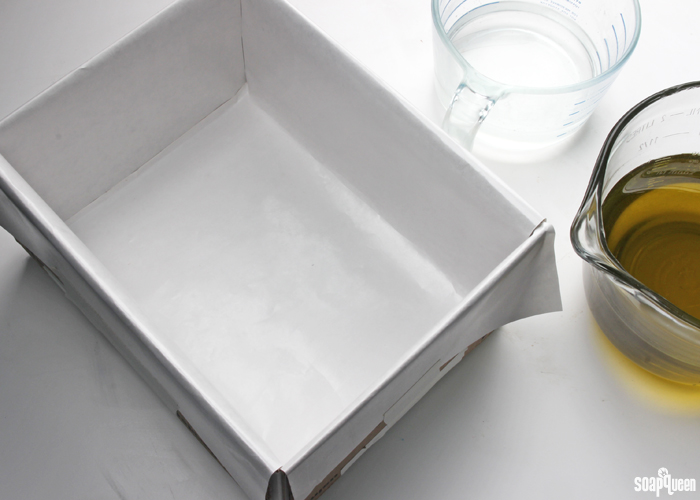
SAFETY FIRST: Suit up for safe handling practices! That means goggles, gloves and long sleeves. Make sure kids, pets, and other distractions and tripping hazards are out of the house or don’t have access to your soaping space. Always soap in a well-ventilated area.
ONE: Slowly and carefully add the lye to the water and gently stir until the lye has fully dissolved and the liquid is clear. Set aside to cool.
TWO: Combine the coconut oil, olive oil and palm oil (remember to fully melt then mix your entire container of palm oil before portioning). Allow the lye water and the oils to cool to 130°F or below (and are ideally within 10 degrees of each other). For this recipe, both the oils and lye were around 120°F.
If you’d like a harder bar of soap that releases faster from the mold, you can add sodium lactate to the cooled lye water. Use 1 teaspoon of sodium lactate per pound of oils in the recipe. For this recipe, you’d add about 2 tsp. sodium lactate.
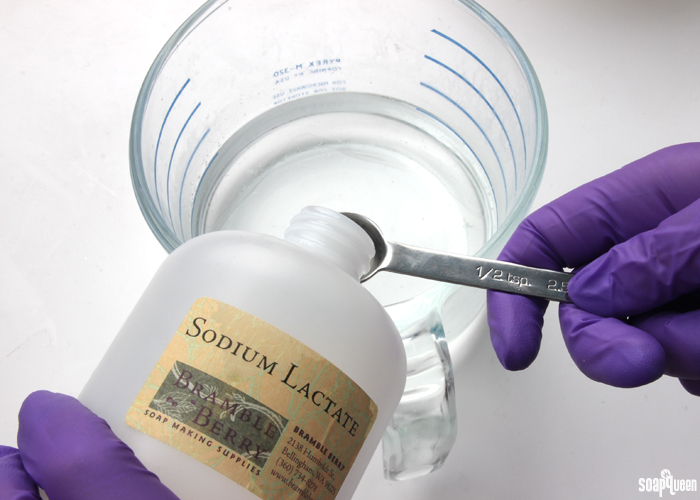
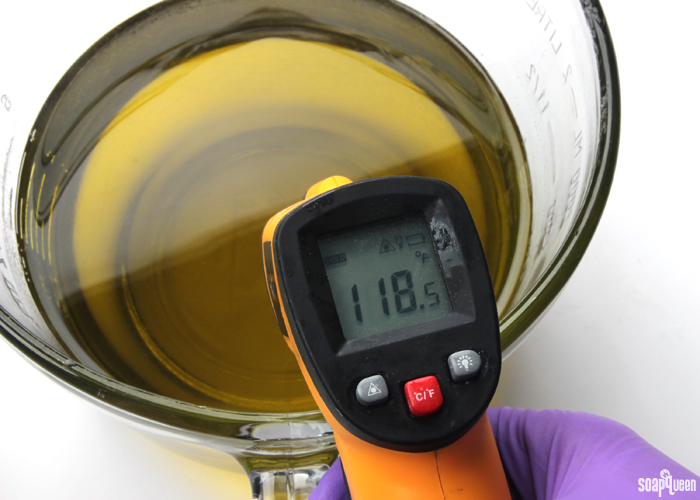 THREE: Place your stick blender into the oils. Gently tap the blender on the bottom of the bowl several times to release any bubbles that got trapped by the stick blender head. This is called, “burping the stick blender.”
THREE: Place your stick blender into the oils. Gently tap the blender on the bottom of the bowl several times to release any bubbles that got trapped by the stick blender head. This is called, “burping the stick blender.”
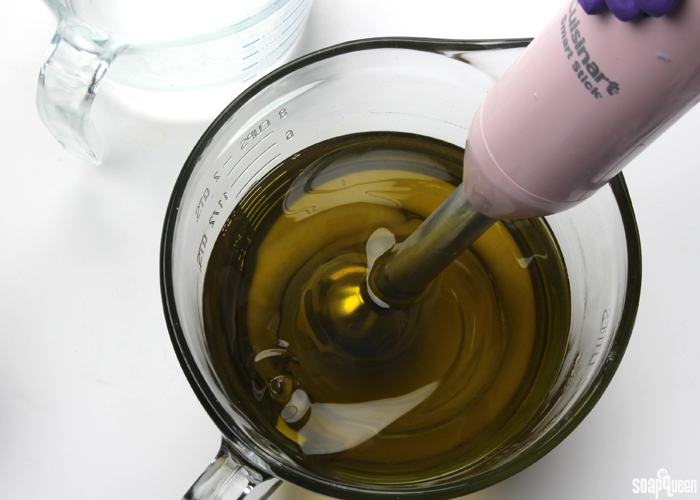 FOUR: Once bubbles no longer rise to the surface of the oils, gentle pour the cooled lye water down the shaft of the stick blender and into the oils.
FOUR: Once bubbles no longer rise to the surface of the oils, gentle pour the cooled lye water down the shaft of the stick blender and into the oils.
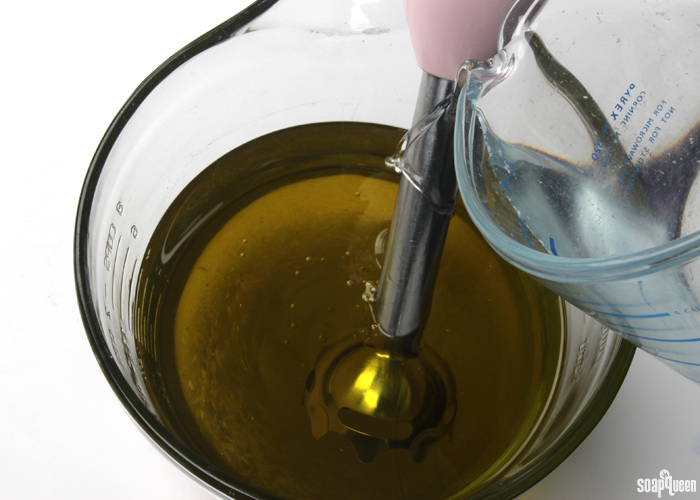 FIVE: Turn on the stick blender and pulse several times. You will immediately see the lye and oils begin to come together, and begin to create a creamy yellow color. Alternate between using the stick blender to stir the mixture, and pulsing the stick blender. After about 30 seconds, test for trace. Because this recipe contains a large amount of olive oil, it will stay at a thin trace longer than recipes with fast moving oils such as butters.
FIVE: Turn on the stick blender and pulse several times. You will immediately see the lye and oils begin to come together, and begin to create a creamy yellow color. Alternate between using the stick blender to stir the mixture, and pulsing the stick blender. After about 30 seconds, test for trace. Because this recipe contains a large amount of olive oil, it will stay at a thin trace longer than recipes with fast moving oils such as butters.
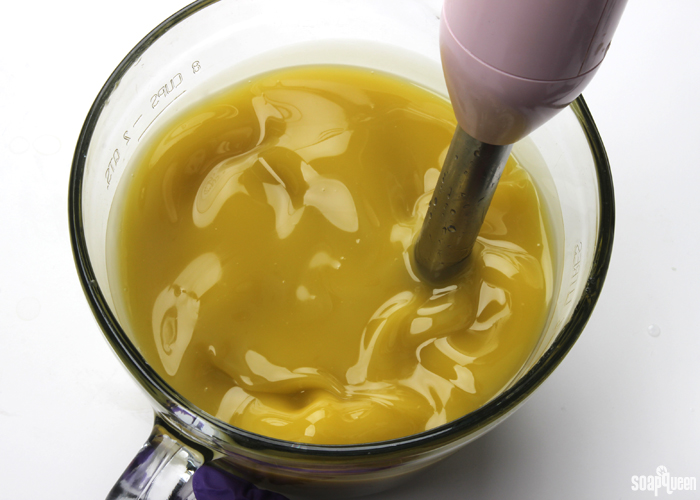 Below, you can see that when the stick blender is pulled out of the mixture, the drips or trailings of soap do not suspend on the top. This soap is still a very thin trace. For some recipes, you may want to stop here. Because this recipe does not need color or fragrance, keep pulsing and stirring with the stick blender.
Below, you can see that when the stick blender is pulled out of the mixture, the drips or trailings of soap do not suspend on the top. This soap is still a very thin trace. For some recipes, you may want to stop here. Because this recipe does not need color or fragrance, keep pulsing and stirring with the stick blender.
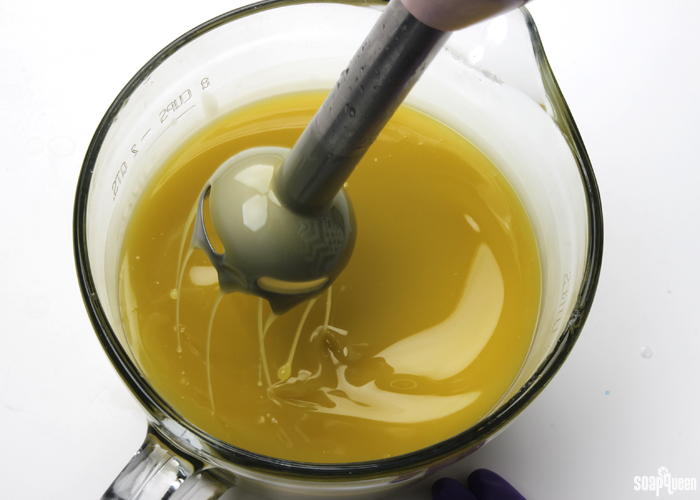 SIX: As you continue to pulse and stir with the stick blender, you may notice the soap starting to lighten in color. It will also start to become thicker. Below is a good example of medium trace. The soap is thick enough to support the trailings and drops on the surface. It’s slightly thinner than pudding. This is a great consistency!
SIX: As you continue to pulse and stir with the stick blender, you may notice the soap starting to lighten in color. It will also start to become thicker. Below is a good example of medium trace. The soap is thick enough to support the trailings and drops on the surface. It’s slightly thinner than pudding. This is a great consistency!
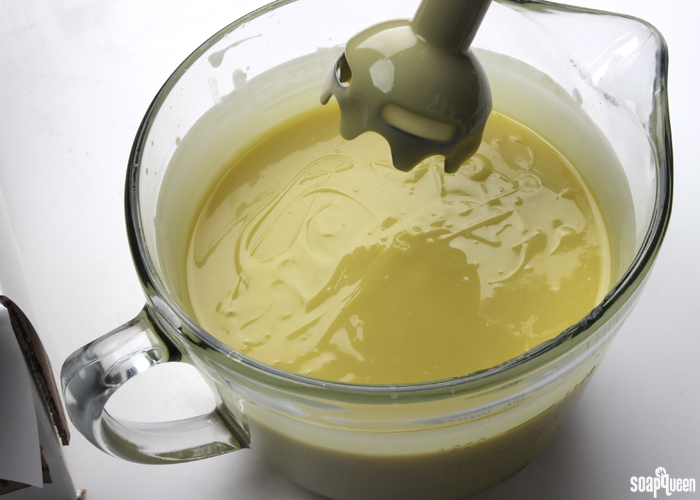
SEVEN: Once your soap has reached medium trace, pour it into the mold until all the soap is in the mold. Scrape the sides of the bowl to ensure you get every last bit of soap!
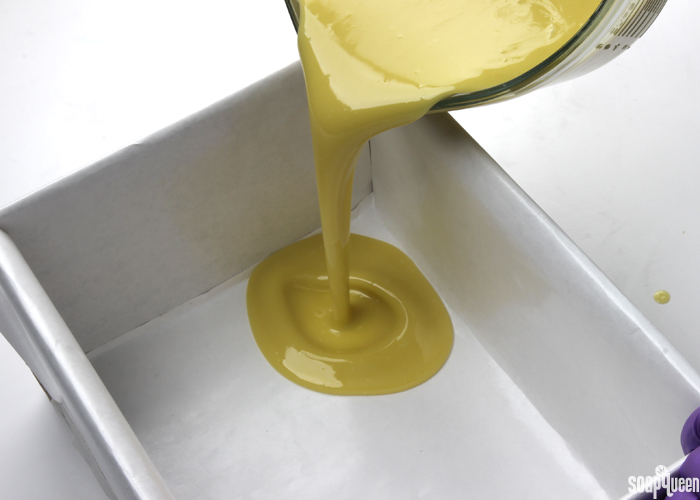
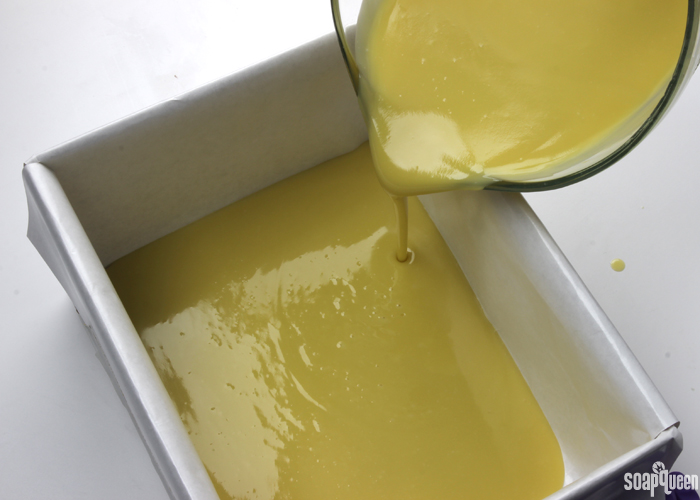 EIGHT: Once the soap is all poured into the mold, firmly tap the box on the counter. Doing so will help bubbles within the soap to come to the surface. Make sure you still have your goggles on! Sometimes soap can jump up during this process =) Spray the top of the soap with 99% isopropyl alcohol. Doing so helps to avoid soda ash from forming. Allow the soap to sit in the mold for 3-4 days. Unmold, and cut into bars. Allow the soap to cure for 4-6 weeks. During this time, water evaporates from the soap making it firmer and longer lasting in the shower. The soap can be used before the full cure time, but will not last as long. It’s best to wait!
EIGHT: Once the soap is all poured into the mold, firmly tap the box on the counter. Doing so will help bubbles within the soap to come to the surface. Make sure you still have your goggles on! Sometimes soap can jump up during this process =) Spray the top of the soap with 99% isopropyl alcohol. Doing so helps to avoid soda ash from forming. Allow the soap to sit in the mold for 3-4 days. Unmold, and cut into bars. Allow the soap to cure for 4-6 weeks. During this time, water evaporates from the soap making it firmer and longer lasting in the shower. The soap can be used before the full cure time, but will not last as long. It’s best to wait!
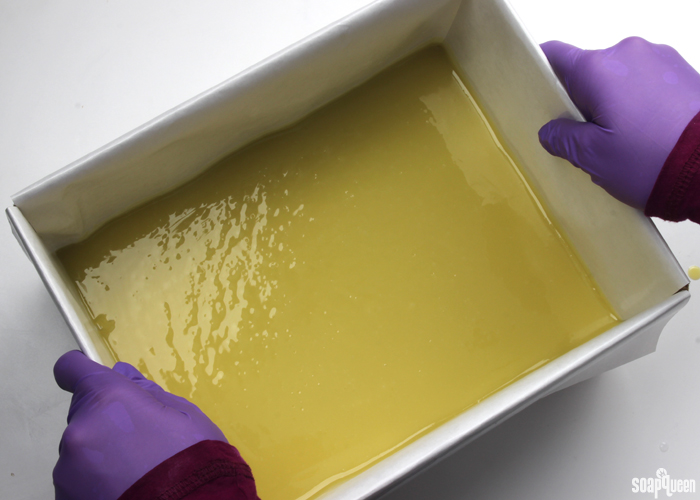
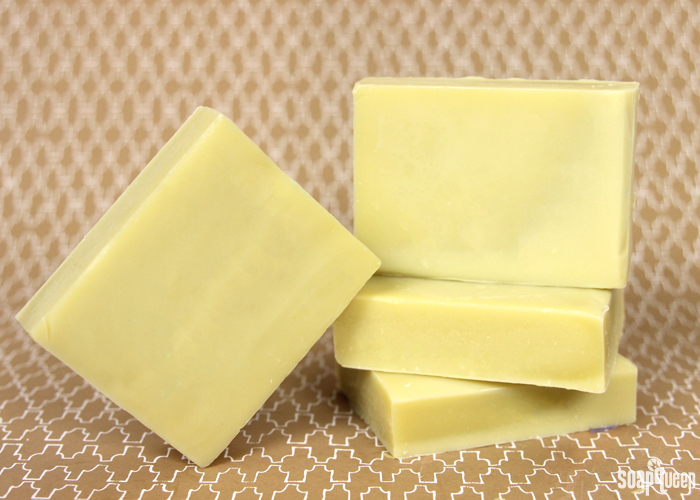
Seasoned soapers, what kind of recipe did you make for your first cold process project? Did you bite off more than you could chew? I would love to hear about your experience! If you are a newbie, I hope you give this project a try =)
- 8 oz. Coconut Oil (24%)
- 15 oz. Olive Oil (44%)
- 11 oz. Palm Oil (32%)
- 4.8 oz. Lye
- 11.2 oz. Distilled Water
- ONE: Slowly and carefully add the lye to the water and gently stir until the lye has fully dissolved and the liquid is clear. Set aside to cool.
- Combine the coconut oil, olive oil and palm oil (remember to fully melt then mix your entire container of palm oil before portioning). Allow the lye water and the oils to cool to 130 degrees or below (and are ideally within 10 degrees of each other). For this recipe, both the oils and lye were around 120 degrees. If you’d like a harder bar of soap that releases faster from the mold, you can add sodium lactate to the cooled lye water. Use 1 teaspoon of sodium lactate per pound of oils in the recipe. For this recipe, you’d add about 2 tsp. sodium lactate.
- Place your stick blender into the oils. Gently tap the blender on the bottom of the bowl several times to release any bubbles that got trapped by the stick blender head. This is called, “burping the stick blender.”
- Once bubbles are no longer rising to the surface of the oils, gentle pour the cooled lye water down the shaft of the stick blender and into the oils.
- Turn on the stick blender and pulse several times. You will immediately see the lye and oils begin to come together, and begin to create a creamy yellow color. Alternate between using the stick blender to stir the mixture, and pulsing the stick blender. After about 30 seconds, test for trace. Because this recipe contains a large amount of olive oil, it will stay at a thin trace longer than recipes with fast moving oils such as butters.
- As you continue to pulse and stir with the stick blender, you may notice the soap starting to lighten in color. It will also start to become thicker. Below is a good example of medium trace. The soap is thick enough to support the trailings and drops on the surface. It’s slightly thinner than pudding. This is a great consistency!
- Once your soap has reached medium trace, pour it into the mold until all the soap is in the mold. Scrape the sides of the bowl to ensure you get every last bit of soap!
- Once the soap is all poured into the mold, firmly tap the box on the counter. Doing so will help bubbles within the soap to come to the surface. Make sure you still have your goggles on! Sometimes soap can jump up during this process =)
- Spray the top of the soap with 99% isopropyl alcohol. Doing so helps to avoid soda ash from forming. Allow the soap to sit in the mold for 3-4 days. Unmold, and cut into bars. Allow the soap to cure for 4-6 weeks. During this time, water evaporates from the soap making it firmer and longer lasting in the shower. The soap can be used before the full cure time, but will not last as long. It's best to wait!
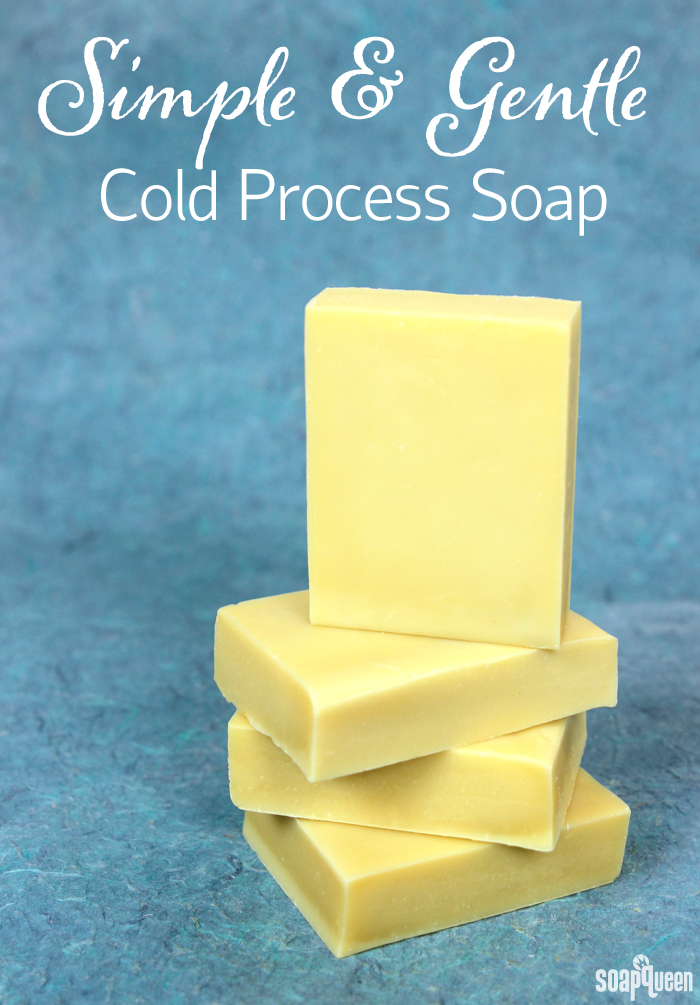
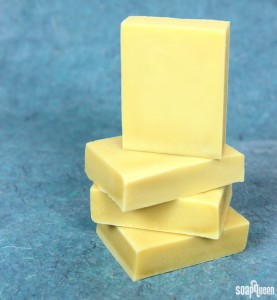


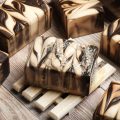
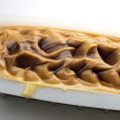
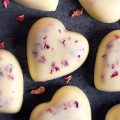
Hi!
Could I add some dried calendula to this? If so, at which point should I add it in?
And also, could I add some green clay? If so, how much and when?
Thanks!! And thank you for all the resources on this site!!!
Yes and yes! For the green clay, you can mix 2 teaspoons of clay into 2 tablespoons of water. That will help the clay disperse evenly. Then, add 1 dispersed teaspoon at a time at trace until you get a color you like. For the calendula, you can add that to the soap at trace as well. About 1 teaspoon per pound is a good place to start.
A few notes – calendula will turn brown in the soap. You can still use the bars, but just keep that in mind. You can skip it, or top the soap with calendula. The calendula will brown on top of the soap as well, but not throughout the bars. Also, clay does accelerate trace, so be prepared to work a bit faster. Learn more about trace here: http://www.soapqueen.com/bath-and-body-tutorials/tips-and-tricks/trace/
-Kelsey with Bramble Berry
French green clay: https://www.brambleberry.com/French-Green-Clay-P6444.aspx
Calendula: https://www.brambleberry.com/Marigold-Calendula-Dried-P4017.aspx
My first 2 batches of soap were CP, 100 % olive oil, and olive oil, milk/honey/oat. It isn’t fancy, and STILL curing! I decided to try my hand at HP, and used coconut and olive oil. Voila! Wonderful success, beautiful hard white soap. Tweaked the recipe a bit and 10 batches later, I’m thrilled. I want to branch out and do a CP colored soap next. Love Brambleberry.
That’s awesome, glad they turned out well! Sounds like you’ve definitely caught the soaping bug. 😉
-Kelsey with Bramble Berry
Hi there!
Your site has been a wonderful guide for my new found love of soap making and I think I’m ready to start CP soaping.
My question is, it’s quite hard to find palm oil where I am I’ve noticed, (that isn’t very expensive)
What oil would you reccomend substituting it out with?
I was considering avocado oil?
Thanks in advance!
Palm oil adds some great firmness to your soap, and there is no direct replacement for it. You can add certain oils and butters to help firm your soap up though. For instance, adding a hard butter like cocoa up to 15% can harden the bars. You can also add coconut oil or tallow up to 33%.
Read more about common oils and what properties they add to soap here: http://www.soapqueen.com/bath-and-body-tutorials/tips-and-tricks/free-beginners-guide-to-soapmaking-common-soapmaking-oils/
This post on substituting oils has some great information too: http://www.soapqueen.com/bath-and-body-tutorials/tips-and-tricks/how-to-substitute-oil-in-cold-process-recipes/
Sodium lactate is helpful as well. It helps the bars unmold more quickly. You can add 1 tsp. of sodium lactate per pound of oils to your cooled lye water. Read more in the Sunday Night Spotlight: Sodium Lactate: http://www.soapqueen.com/bramble-berry-news/sunday-night-spotlight-sodium-lactate/
Here are some links to palm-free recipes you may like:
Palm Free Vertical Twist: http://www.soapqueen.com/bath-and-body-tutorials/cold-process-soap/palm-free-vertical-twist-tutorial/
Palm Free In The Pot Swirl: http://www.soapqueen.com/bath-and-body-tutorials/cold-process-soap/a-palm-free-in-the-pot-swirl/
Formulating Cold Process Recipes: http://www.soapqueen.com/bath-and-body-tutorials/tips-and-tricks/formulating-cold-process-recipes/
-Kelsey with Bramble Berry
I am looking forward to making my first batch. I love the simplicity of this recipe.
As I attempt to understand the process I plugged the recipe into your lye calculator. It came up with 5.1 ounces lye versus the 4.8 in the recipe. I will follow the recipe of course. I think I entered the correct weight of each oil. Just wondering where I may have gone wrong so I learn to use the calculator correctly.
Thanks for the website, videos and all!
I am looking forward to making my first batch. I love the simplicity of this recipe.
As I attempt to understand the process I plugged the recipe into your lye calculator. It came up with 5.12 ounces lye versus the 4.8 in the recipe. I will follow the recipe of course. I think I entered the correct weight of each oil. Just wondering where I may have gone wrong so I learn to use the calculator correctly.
Thanks for the website, videos and all!
Updated!
Upon double checking – I selected palm kernel oil, not palm oil. I thought I read somewhere on your site you used palm kernel oil in your recipes? Must have been mistaken. I do believe this is where I slipped up.
You can use palm kernel oil, but it is only able to be used up to 15% and will make the soap thicken faster. Palm oil is best for this recipe. Learn more about that here: http://www.soapqueen.com/bath-and-body-tutorials/tips-and-tricks/free-beginners-guide-to-soapmaking-common-soapmaking-oils/
-Kelsey with Bramble Berry
Hi!
I loved this recipe. I can mix colorant and fragrance and make any soap that I desire. Though I have a few questions.
1. Palm oil is not easily available where I stay. so can I substitute it with any other oil?
2. Is there any difference between coconut oil and virgin coconut oil? Can I use virgin coconut oil wherever u have mentioned coconut oil?
Please reply!!!!
So glad you love the recipe! Palm oil adds some great firmness to your soap, and there is no direct replacement for it. You can add certain oils and butters to help firm your soap up though! For instance, adding a hard butter, like cocoa butter up to 15%, can harden the bars. You can also add coconut oil or tallow up to 33%.
Read more about common oils and what properties they add to soap here: http://www.soapqueen.com/bath-and-body-tutorials/tips-and-tricks/free-beginners-guide-to-soapmaking-common-soapmaking-oils/
This post on substituting oils has some great information too: http://www.soapqueen.com/bath-and-body-tutorials/tips-and-tricks/how-to-substitute-oil-in-cold-process-recipes/
Sodium lactate is helpful as well. It helps the bars unmold more quickly. You can add 1 tsp. of sodium lactate per pound of oils to your cooled lye water. Read more in the Sunday Night Spotlight: Sodium Lactate: http://www.soapqueen.com/bramble-berry-news/sunday-night-spotlight-sodium-lactate/
As for the coconut oil, you can use virgin in place of the regular coconut oil. Just remember to run this recipe through the Lye Calculator after any substitutions, as virgin coconut oil has a slightly different SAP value. 🙂
Lye Calculator: https://www.brambleberry.com/Pages/Lye-Calculator.aspx
-Kelsey with Bramble Berry
Was wondering if fragrance were to be added, about how much would be ok without effecting the quality of the soap?
You can use our Fragrance Calculator to determine the amount of scent! It will give you a light, medium and strong recommendation. 🙂
Fragrance Calculator: https://www.brambleberry.com/Pages/Fragrance-Calculator.aspx
-Kelsey with Bramble Berry
Hi Kelsey,
After watching a bunch of SoapQueen videos and reading non-stop about soaping, I finally felt confident enough to try it out. This recipe was super easy, and I think it came out great. I still have to wait for it to cure, but the bars look lovely.
I was wondering, when figuring out the weight of the soap (to put into the fragrance calculator) should I add up the weight of all the ingredients? Or do I leave the weight of the water out?
Thanks!
Hi Andrea! So glad to hear your recipe turned out well. It’s going to feel amazing on the skin. For the Fragrance Calculator, you’ll want to enter the total weight of the soap. That includes oil, water, and lye. 🙂
-Kelsey with Bramble Berry
In which step do you add color and fragrance
Hi Tina! Color and fragrance is added when the oils and lye water are first emulsified. That’s called thin trace. You can see that process in this tutorial: https://www.soapqueen.com/bath-and-body-tutorials/back-to-basics-crisp-cotton-swirl-cold-process/
This four-part video series about cold process soapmaking talks more about how to add fragrance and color: https://www.youtube.com/watch?v=yR6ttCSrLJI&list=PLAADF6209996265D2
-Kelsey with Bramble Berry
What would make a good substitute for Palm Oil and is the mixer used above the only type that can be used? I have a regular beater but not sure if that will work
Palm oil adds some great firmness to your soap, and there is no direct replacement for it. You can add certain oils and butters to help firm your soap up though! For instance, adding a hard butter, like cocoa butter up to 15%, can harden the bars. You can also add coconut oil or tallow up to 33%. 🙂
Read more about common oils and what properties they add to soap here: http://www.soapqueen.com/bath-and-body-tutorials/tips-and-tricks/free-beginners-guide-to-soapmaking-common-soapmaking-oils/
This post on substituting oils has some great information too: http://www.soapqueen.com/bath-and-body-tutorials/tips-and-tricks/how-to-substitute-oil-in-cold-process-recipes/
Sodium lactate is helpful as well. It helps the bars unmold more quickly. You can add 1 tsp. of sodium lactate per pound of oils to your cooled lye water. Read more in the Sunday Night Spotlight: Sodium Lactate: http://www.soapqueen.com/bramble-berry-news/sunday-night-spotlight-sodium-lactate/
Here are some links to palm-free recipes you may like:
Palm Free Vertical Twist: http://www.soapqueen.com/bath-and-body-tutorials/cold-process-soap/palm-free-vertical-twist-tutorial/
Palm Free In The Pot Swirl: http://www.soapqueen.com/bath-and-body-tutorials/cold-process-soap/a-palm-free-in-the-pot-swirl/
Formulating Cold Process Recipes: http://www.soapqueen.com/bath-and-body-tutorials/tips-and-tricks/formulating-cold-process-recipes/
Also, we definitely recommend a stick blender. A regular beater usually takes at least two hours to emulsify the soap, while the stick blender does that in just a minute or two. 🙂
Black Stick Blender: https://www.brambleberry.com/Black-Stick-Blender-P5245.aspx
-Kelsey with Bramble Berry
Hi! First of all, thank you so much for making all the resources available on your website, plus all the videos!
I need a little help. I am very new to soapmaking (actually, is there a word that’s even before a person being a newbie? If so, that’s me. =) ). I am also very overwhelmed at this point. I made a list of things I needed to buy, go everything, came home and forgot a couple of things, this morning went out again, and had to go out yet again. I got supplies without really thinking about the recipe. Yup, dumb, I know. The problem is, by now I am beyond frustration.
So… what I have is this: olive oil, coconut oil, castor oil. I don’t have palm oil. I have all the other stuff too: containers, parchment paper, something to use as a mold, lye, new hand blender, and everything for safety (goggles, mask, gloves, apron). I just need to start this. Please, can you tell me which way to go to find a recipe that uses what I have instead of me going out again and find some place to buy palm oil? Thank you!
Absolutely! You have the makings of a very nice recipe. 🙂
A great place to start is 33% coconut oil, 3% castor oil and 64% olive oil. The coconut oil is nice and cleansing, the castor oil helps create bubbles and the olive oil is nice and moisturizing. Give that a try to see what you think! Then, you can adjust from there.
This recipe has more information on formulating recipes: http://www.soapqueen.com/bath-and-body-tutorials/tips-and-tricks/formulating-cold-process-recipes/
Bars with a lot of olive oil do take longer to harden and unmold. Adding 1 teaspoon of sodium lactate per pound of oils to your cooled lye water really helps: http://www.soapqueen.com/bramble-berry-news/sunday-night-spotlight-sodium-lactate/
-Kelsey with Bramble Berry
Hi I was just wondering if you could sub in any oils or butters in this recipe?
You can! Keep in mind every butter and oil you add will change the consistency of this bar. This post talks about common oils, what they do in soap and how much to use: http://www.soapqueen.com/bath-and-body-tutorials/tips-and-tricks/free-beginners-guide-to-soapmaking-common-soapmaking-oils/
This post talks more about formulating cold process recipes: http://www.soapqueen.com/bath-and-body-tutorials/tips-and-tricks/formulating-cold-process-recipes/
And this one talks about how to substitute oils in your recipes: http://www.soapqueen.com/bath-and-body-tutorials/tips-and-tricks/how-to-substitute-oil-in-cold-process-recipes/
-Kelsey with Bramble Berry
Love the website. Two questions, is it important to use distilled water? And I used a high superset recipe with saltwater instead of distilled, any experience with this?
Thanks
It is important to use distilled water! Tap water can have microbes or bits of metal inside that do weird things in your bar. If you like, you can add salt to that distilled water. That’s called a brine bar. Learn how to make it here: https://www.soapqueen.com/bath-and-body-tutorials/cold-process-soap/brine-and-rose-clay-cold-process-soap-soleseife-soap/
-Kelsey with Bramble Berry
Can I add black cherry fragrance oil to this?
You sure can! Find out how much to add with our Fragrance Calculator: https://www.brambleberry.com/Pages/Fragrance-Calculator.aspx
-Kelsey with Bramble Berry
Black Cherry Fragrance Oil: https://www.brambleberry.com/Black-Cherry-Fragrance-Oil-P4607.aspx
I just made my first batch of CP soap 2 days ago using olive oil, coconut oil, castor oil, palm oil, and shea butter. Added lavender EO at 5% to keep it simple. My question is that I’d love to use Frankincense and Myrrh oils in my next batch, but I’m not sure how much of each I should add. I’ve read that certain oils like cinnamon and clove need to be used very sparingly. Are Frankincense and Myrrh safe to use in amounts similar to lavender? Is there a chart, or an EO calculator somewhere that would include these two? I have had no luck searching the internet. Thanks.
We have a Fragrance Calculator that tells you exactly how much to use! Find it here: https://www.brambleberry.com/Pages/Fragrance-Calculator.aspx
We also have a post on how to blend essential oils safely that’s really helpful. I’ll link it below. 🙂
How to Blend Essential Oils Safely: https://www.soapqueen.com/bath-and-body-tutorials/tips-and-tricks/how-to-blend-essential-oils-safely/
-Kelsey with Bramble Berry
Thanks for your response. I actually meant that I’d like to use 100% pure Frankincense essential oil and 100% pure Myrrh essential oil for my next batch. The BB calculator that you linked to includes a Frankincense/Myrrh blended fragrance, not the EOs. Would you know of a chart or calculator that includes these two essential oils?
Because we don’t carry those I’m not 100% sure of the usage rate. Sorry about that. In general, we recommend .7 oz. of essential oil per pound of cold process soap. That is the total amount, including both frankincense and myrrh. I would recommend double checking with the manufacturer to be sure. 🙂
This post has more general usage rates for fragrance and essential oil: https://www.soapqueen.com/bath-and-body-tutorials/tips-and-tricks/use-fragrance-calculator/
-Kelsey with Bramble Berry
I just made my first batch of CP last night using this recipe. I am interested in making my next batch with your Oatmeal Milk and Honey FO and ground oatmeal. Do I have to change anything to adjust for the oatmeal? Also, your fragrance calculator does not work in my iPad, can you tell me what fragrance amount would be?
You won’t need to change anything about the recipe for the oatmeal! It is considered an additive. I would recommend mixing 1 teaspoon of oatmeal with 1 tablespoon of a lightweight oil like sweet almond. Then, you can add that at trace. It helps the oatmeal mix in easily and prevents clumps.
For the fragrance, it would be 1.4 oz. for a light scent, 2.1 for medium and 2.5 for strong. 🙂
-Kelsey with Bramble Berry
Colloidal oatmeal: https://www.brambleberry.com/Colloidal-Oatmeal-P5565.aspx
Oatmeal Milk and Honey Fragrance Oil: https://www.brambleberry.com/Oatmeal-Milk-And-Honey-Fragrance-Oil-P3931.aspx
Hi I’m Noel, just wanted to know if you have any beginner tips for someone like me. I found some goats milk on Amazon. Could that be used in the soap making as well? Maybe to replace or just a filler.
This Back to Basics series has some amazing tips and recipes for beginners! You can find the roundup of the posts here: https://www.soapqueen.com/bath-and-body-tutorials/back-to-basic-series-roundup-quiz/
We also have a great post with more tips here: http://www.soapqueen.com/bramble-berry-news/beginning-soaper-resource-roundup/
You can use goat milk in soap! It can be used in place of the water. It is a more advanced technique because it requires some extra steps. You may want to try a few batches with water first to get comfortable. Learn more about working with milk here: http://www.soapqueen.com/bath-and-body-tutorials/tips-and-tricks/how-to-add-lye-to-milk-for-cold-process-soap/
Of course, we are here if you have any questions. Feel free to ask, we’re happy to help. 🙂
-Kelsey with Bramble Berry
Hi!
Is there a specific ratio when using these oils? On what basis did you decide the grams of each?
Also, can you add bee wax to such kind of recipes?
Sorry if my questions are a bit naive and thanks for the help in advance!
Rima
No worries, we’re happy to help! Each oil adds certain properties to the bar. Coconut oil is cleansing and firming, palm oil is firming and olive oil is moisturizing. We have found these amounts create a bar that’s firm, cleansing and moisturizing.
After you make a few batches, you may find your perfect recipe is different than this one. If you like softer, more moisturizing bars, you can add more soft oils like avocado oil. If you like firmer bars, you can increase the amount of coconut and palm. This recipe is a great basic one to start with because it’s nice and easy. 🙂
Read more about common oils and what properties they add to soap here: http://www.soapqueen.com/bath-and-body-tutorials/tips-and-tricks/free-beginners-guide-to-soapmaking-common-soapmaking-oils/
And read more about formulating cold process recipes here: http://www.soapqueen.com/bath-and-body-tutorials/tips-and-tricks/formulating-cold-process-recipes/
-Kelsey with Bramble Berry
Hi!
I just discovered this wonderful world of soap making recently by accident and I’m in the process of gathering all the tools and ingredients. I actually have few items sitting in the cart on brambleberry.com. I’m so excited!
Browsing through your posts on cold process soaps, I decided to fight my urge to do the beautiful colored soaps and do this one instead as my first ever cold process soap.
I just have a few questions:
1. Are the “coconut oil” that you use in your recipes just coconut oil or virgin coconut oil? I see some explanations on the difference of fractionated and normal coconut oil and I understand that the fractionated is the one that’s liquid in room temperature. So if it is not specified as fractionated, is it safe to assume it’s virgin? Apologies if I missed the answer to this on anywhere of this blog but I couldn’t seem to find the straight forward answer..
2. I tried looking for a supplier of sodium lactate locally but I’m having a hard time (I’m from the Philippines). I plan to include this on on my first order but it will be very costly if I opt to have it shipped every time I run out. I read somewhere about using table salt for this purpose, is this something you would recommend as a substitute?
Thank you !
Donna
Hi Donna!
Our coconut oil is 76F coconut oil. There are several types – 76F, 92F and virgin coconut oil. All of those are really similar and are solid at room temperature. You can use any of those for this recipe! Fractionated coconut oil is liquid at all times. Read more about the difference here: https://www.soapqueen.com/bath-and-body-tutorials/tips-and-tricks/sunday-night-spotlight-coconut-oil/
You can use a salt solution to harden soap in place of sodium lactate! To make the solution, mix 1 teaspoon of regular table salt into 1 ounce (by weight) of warm distilled water. Stir until the salt is fully dissolved. We recommend 1 teaspoon of salt in 1 ounce of water per pound of soap. Make sure to discount the salt water solution from your liquid amount. Then, add the solution at trace. 🙂
We used that solution in this tutorial with great results: http://www.soapqueen.com/bath-and-body-tutorials/cold-process-soap/palm-free-vertical-twist-tutorial/
-Kelsey with Bramble Berry
Thank you! 🙂
You’re welcome!
So I tried this recipe and so far it has gone well.. although i just looked to check and see if it’s working and it is turning purple… i used the basic recipe and added eucalyptus eo as well as split the batch and colored(or tried to color) the soap green and blue then swirl it together… why did it turn purple?? It’s only been like 4 hours but it looks like it’s gonna be purple.
I may have figured it out while washing up dishes…. the spatula I used was red and well red plié blue is purple…. so next question having the red coloring from my spatula bleed into my soap is the soap still ok to use??
I would recommend checking with the manufacturer of the spatula. If the dye is skin safe, the soap should be fine to use. If not, you may want to avoid using it to be extra careful. For your next batch, you may want to use a heat resistant spatula with color that won’t transfer. We use this spatula all the time in our Soap Lab with great results: https://www.brambleberry.com/Silicone-Spatula-P5707.aspx
-Kelsey with Bramble Berry
Hi,
usualy in your vids I can see 1 day till unmolding. In this recipe is 3-4 days. Why such a lond time perion in this case?
Thanks
A general unmolding time is about 3-5 days! It depends on the recipe and how the soap is stored. For instance, if your soap has mostly soft oils like olive, it will take longer to unmold. If it’s a lot of hard oils, you will be able to unmold it earlier. I would recommend waiting 2-3 days before unmolding. Then, tap the soap. If it’s firm to the touch, you can unmold. If not, let it sit for a couple more days. 🙂
To speed that process up, you can add 1 teaspoon of sodium lactate per pound of oils to your cooled lye water. Read more about sodium lactate here: http://www.soapqueen.com/bramble-berry-news/sunday-night-spotlight-sodium-lactate/
-Kelsey with Bramble Berry
Following the directions on my simple recipe, I attempted to unmold after about 36h. The soap is sticky and the mold didnt come out nice. It’s a firm plastic soap/candy type mold that came with a beginner kit. Is my problem more with the mold itself or unmolding too soon? Is it possible to re-batch the whole thing and try the mold again? Thx!
I think that soap was unmolded too soon! If you find it’s sticky or soft to the touch, let it sit for a few more days until it’s firm. That should help prevent any drag marks or bumps. 🙂
If you like, you can let that soap harden and use something like the Soap Shaver: https://www.brambleberry.com/Soap-Shaver-P6331.aspx
That will help shave off the drag marks for a smooth surface! You can also rebatch the soap if you like. Learn how here: http://www.soapqueen.com/bath-and-body-tutorials/cold-process-soap/soap-queen-tv-presents-how-to-make-rebatch-soap-2/
-Kelsey with Bramble Berry
Hi there,
just short question for measurements – are all measurements for weight?
I mean if all ingredients (oils, lye, water) are in weight units (like grams) or liquids (oils, water) are in mililiters and solid (lye) in grams?
Thanks
We usually do a mix of both! If the ingredients are listed in ounces or grams, that is a weight measurement. If they’re listed in teaspoons, tablespoon, cups or mililiters, that is a volume measurement. This recipe is measured entirely by weight. 🙂
Read more about weight vs. volume here: http://www.soapqueen.com/bath-and-body-tutorials/tips-and-tricks/a-guide-to-weight-vs-volume/
-Kelsey with Bramble Berry
Thank for answer.
Today I made my first try to make a soap – this recipe. Looking forward for the result 🙂
Just one additional question: in other recipies I have seen you cover mold into foil and towel then. I did it also for this recipe. How long should be covered? Whole time till unmolding (2-3 days) or less?
Thank you
Oh that’s awesome, glad you gave this recipe a try! It feels really great on the skin. 🙂
By covering the soap, you’re forcing it through gel phase. During gel phase, the soap gets really hot and gelatinous. It doesn’t affect the final bars at all. Some soapers prefer it because it makes the colors pop. If you do choose to gel the soap, we recommend keeping it covered for about 24 hours. Then, you can remove the towel and let the soap sit another 2-3 days before unmolding!
Read more about gel phase here: http://www.soapqueen.com/bath-and-body-tutorials/tips-and-tricks/gel-phase/
And more about when to insulate the soap here: http://www.soapqueen.com/bath-and-body-tutorials/tips-and-tricks/when-to-insulate-handmade-soap/
-Kelsey with Bramble Berry
I love this recipe, I did add colorants and make a design but I LOVE it!!
So glad you love it Tasha! This recipe is perfect for customizing. Enjoy! 🙂
-Kelsey with Bramble Berry
Anne-Marie, I’m your newest #1 fan!
I would like to read everything I can before making my first batch, not to be perfect, but trying not to waste anything 😉
Thank you for sharing all these wonderful ideas, tips, expertise, goodness… Oh my! I thank God I found your movies and websites.
Bestest Regards from São Paulo!!
Videos**, I mean
You’re very welcome Kate, so glad you’re enjoying the posts and videos! Thanks a bunch for watching. If you have any questions before getting started definitely let us know. We’re happy to help. 🙂
-Kelsey with Bramble Berry
I followed the directions very carefully and the soap came out lovely. It lathers well but it seems to leave my skin feeling dry afterwards. Is that normal?
It depends on your skin type! This recipe has coconut oil, which is very cleansing. If your skin is on the dry side, the coconut oil can be drying. For your next batch, you can add more moisturizing oils like avocado and sweet almond and reduce the coconut and palm oil. That will create a softer bar that’s moisturizing for dry skin. 🙂
Read more about common oils and how much to add to soap here: http://www.soapqueen.com/bath-and-body-tutorials/tips-and-tricks/free-beginners-guide-to-soapmaking-common-soapmaking-oils/
This post on Formulating Cold Process Recipes is helpful too: http://www.soapqueen.com/bath-and-body-tutorials/tips-and-tricks/formulating-cold-process-recipes/
-Kelsey with Bramble Berry
Hi Kelsey,
Thank you for everything that you post and publish. You have given me a new talent I never thought I could ever develop. Can you tell me, is it okay to add aloe jelly to this soap to give it more moisturizing attributes? Do I need t run it through a lye calculator with the aloe??
Thank you Tamara, so glad you like the Soap Queen blog! You can definitely add aloe vera to this recipe. We like to use aloe vera liquid in place of the water. So, all 11.2 ounces of liquid can be aloe vera, or you can do a 50/50 mix, 30/70 mix, etc. The aloe vera liquid does change colors to a yellowish green when the lye is added, so we recommend cooling it beforehand to prevent some of that discoloration. 🙂
Learn more about working with aloe vera liquid here: https://www.soapqueen.com/bath-and-body-tutorials/cold-process-soap/defying-the-rules-of-soapmaking-100-coconut-oil-soap-with-aloe-vera-and-a-mantra-swirl/
Aloe liquid: https://www.brambleberry.com/Aloe-Vera-Liquid-P3704.aspx
We also used fresh aloe in this video: https://www.youtube.com/watch?v=FthYuM94DuA
That recipe is from Anne-Marie’s new book, Pure Soapmaking: https://www.brambleberry.com/Pure-Soap-Making-How-to-Create-Nourishing-Natural-Skin-Care-Soaps-P6298.aspx
-Kelsey with Bramble Berry
Thank you, SUPER EXCITED!!
You’re welcome! Have fun. 🙂
-Kelsey with Bramble Berry
I think it would be a good idea to recommend sustainable palm oil for your recipes, because regular palm oil is soooo harmful to our planet. Many people do not know of the negative effects, and it would be great if you did a little extra and made them aware through your blog. Non sustainable palm oil is not really guilt free, unfortunately. Otherwise, love your site 🙂
Hi Cailin!
Our palm oil is sustainable! We are members of the Roundtable for Sustainable Palm Oil. It was founded to create a system for certifying sustainably grown palm oil, and to create guidelines of membership for certified growers. Members of the RSPO must report on and provide better working conditions, better wages, and foster local discussions and input on their impact on local and native land. You can read more about that here: https://www.soapqueen.com/business/on-palm-oil/
-Kelsey with Bramble Berry
Hi. I’ve only made HP soap (50/50 coconut oil and olive oil and LOVE it!) so far and think I’d prefer it over CP soap. Can I hot process this exact recipe? Thanks!
Hi Jodie!
You sure can! This recipe will work for the hot process method as well. That goes for all of our cold process recipes. 🙂
Learn more about making hot process soap in this video: https://www.youtube.com/watch?v=mxTXwxbpzLM
-Kelsey with Bramble Berry
hello soap queen, i used the same recipe, 8 oz. Coconut Oil (24%), 15 oz. Olive Oil (44%), 11 oz. Palm Oil (32%), 4.8 oz. Lye, 11.2 oz. Distilled Water, but after that i made the lye water equal to the all oils in weight ( i.e. if the total weight of oils is 8.3 oz, then also i measured 8.3 0z of lye water). my finished was very hard only after 3 days, is there any problem when i use this soap? the reason why i did that is that i wanted to test whether my soap don’t thicken very quickly before i pour it in the mold, and to some extent my experiment was successful. is it a good idea or bad? help me.
Hi Mukasa!
Just to clarify, you added 8 ounces of coconut oil, 15 ounces olive oil, 11 ounces of palm oil and 8.3 ounces total of lye water? Do you know how much or both the lye and the water you added to the batch exactly? Thanks! 🙂
-Kelsey with Bramble Berry
hello, thank you for answering my question, then am going to try to soaping around 100-130F as you recommended i will be informing you the results, but with the Hot process i see a lot of bubbles in your soap (basing on your photos you posted) what happened?
thank you.
Just to clarify, are you referring to the more rustic texture of the hot process soap? You can see that texture here: https://www.soapqueen.com/bath-and-body-tutorials/lavender-lemongrass-hot-process-soap-on-soap-queen-tv/
Hot process has a texture sort of like mashed potatoes. Because it is thicker, it can form air bubbles as you’re putting it in the mold. To get rid of those air bubbles, make sure to tap the mold on the counter as you put the soap in. That will disperse any bubbles. 🙂
-Kelsey with Bramble Berry
Hello, thank you for sharing all the awesome recipes, am happy with that.
yesterday i tried this recipe and my ingredients are as follows; 22 oz palm oil, 22 oz fortune buto (it is a cooking oil in my country, it’s a light oil because it doesn’t become solid in room temperature), 12 oz coconut oil, 12 oz olive pomace oil, 9.6 oz lye, 22.4 oz distilled water. In short i doubled the recipe you gave us. No color & fragrance oil, the room temperature was good & the oils & lye water were cool. unfortunately, the soap thicken up too quickly in 5 seconds, i even failed to pour it in my mold because it was like already cure soap, ooooooh. can i increase lye water solution or what went wrong?
Hi Mukasa!
Hmm, I’m wondering if your soap had false trace. If the lye water is a bit too cool when it’s added, it can start to solidify the hard oils (coconut) in your batch. With false trace, the soap will start to thicken almost as soon as the lye is added. Read more about false trace here: http://www.soapqueen.com/bath-and-body-tutorials/tips-and-tricks/trace/
For the soap now, I would recommend using the Hot Process Hero method. That will get it nicely emulsified and take care of any separation: http://www.soapqueen.com/bath-and-body-tutorials/tips-and-tricks/hot-process-hero-2/
To prevent false trace in your next batch, we recommend soaping around 100-130F. That ensures everything stays melted as you soap and gives you time to work with your design. 🙂
-Kelsey with Bramble Berry
hello, i tried to soap at around 120F and there was a slight improvement as far as quick thickening of my soap is concerned because it took some few seconds to thicken, but still it doesn’t allow me to pour into my molds.
help still.
Hmm, I’m a bit stumped as to why that’s happening! How long are you stick blending your soap?
-Kelsey with Bramble Berry
i stick blending my soap for only like 30 seconds and it thickens yet i soap at around 120F, what is the problem?
I know in the comment above you mentioned something about making the lye water equal to the oils, and that your recipe was quite hard. How much lye and water are you using for your recipe?
-Kelsey with Bramble Berry
Hello,
Thanks for this recipe. I have recently bought stuff to try soap making and I had a recipe wanted to try and bought the ingredients according to it. After doing more research I have decided I don’t want to do the recipe as the measurements are in cups and I have come to realise it is better to use weights. I have already bought all the ingredients and they are the same you have listed however instead of palm oil I have grapeseed oil. Are you able to tell me what weight of grapeseed oil I would use? Also if I wanted to put some lavender essential oil in how many drops would I use in this recipe?
Thanks in advance.
Carly
Hi Carly!
I can definitely help you out! What oils do you have for the recipe? Let me know and I can suggest some combinations you may like. 🙂
Also, you can use our Fragrance Calculator to find out exactly how much lavender essential oil to add to your recipe: http://www.brambleberry.com/Pages/Fragrance-Calculator.aspx
-Kelsey with Bramble Berry
Hi Soap Queen,
Firstly, I thank you for this page very much. I’ve made three batches of cold process soap before, they turn out ok for home use, but I would like to ask a couple of questions
1) I find it hard to determine what is medium trace. What would happen to soaps if I stopped too early?
2) I use a recipe that uses breastmilk, recommended by another more experienced soap maker, i find myself using a lower temperature – approx 30’C (~86’F). Should I bring the temperature higher?
Thank you so much for your help,
Karen
You’re welcome, so glad you like the page Karen! 🙂
When you’re stick blending your soap, you want to mix until it’s fully emulsified. You can tell it’s emulsified when there are no streaks of oil in the batch. That can take as little as 30 seconds of stick blending! The consistency will be very thin, but all one color. This is called thin trace. We like to stick blend to thin trace when we’re working with more intricate designs, as it gives us more time to work. See an example of thin trace here: http://www.soapqueen.com/bath-and-body-tutorials/tips-and-tricks/trace/
As for your temperatures, that is a good level to be at! If milk gets too hot, it can scorch. That causes discoloration and an unpleasant smell. A temperature of 86F is a good place to be. 🙂
Read more about working with milk here: http://www.soapqueen.com/bath-and-body-tutorials/tips-and-tricks/how-to-add-lye-to-milk-for-cold-process-soap/
-Kelsey with Bramble Berry
Thank you very much Kelsey, seems like my method is alright. Definitely great links you’ve shared with me. Will be experimenting with other recipes on the site!
Wish there was a way for cheaper shipping for products from brambleberry to Hong Kong!
You’re welcome Karen! Also, some of our international customers like to go together on shipping to help split those costs. That may be an option for you. 🙂
-Kelsey with Bramble Berry
hi! this was a very encouraging recipe 🙂 i haven’t tried my hand in making soap before, but i’m gathering supplies and information. i don’t live in the U.S so i decided to try making soap with ingredients that are available where i live and see if i like it and then “invest” with buying butters and FO from bramble berry since the shipping is quite high to justify as an absolute beginner. the problem that i’m currently facing is that its very difficult for me to find any hard oils like cocoa or shea butter, at the same time coconut butter is available but is really expensive and at the same time i don’t want to use only liquid oils and leave the soap to cure for a year!
i’m sorry that this was a long intro!! but here is the question.. i thought that palm oil is a hard oil that is used to make the soap harder, the only palm oil that i could find is palm olein oil, which i think is fractioned palm oil w/o stearic acid which is supposed to be the hardening agent in palm oil.
the oils that are available to me so far are; olive oil , sunflower oil, soy oil , palm olein oil, safflower oil , canola oil , castor oil , and i might be able to make some tallow at home if i’m really determined (which honestly i’m not so keen on doing!).
the last thing is that if using a recipe from a combination of the oils above is 8 weeks of curing enough ??
many thanks and sorry for the super long and annoying comment!
Hi Sana!
No worries, we are happy to help!
If your recipe is mostly soft oils, there are a couple tricks to help it harden and cure more quickly! Water discounting is one option. With less water in the batch, there is less to evaporate and the soap will cure more quickly. Learn how to water discount here: http://www.soapqueen.com/bath-and-body-tutorials/tips-and-tricks/water-discounting-cold-process-soap-how-why/
Sodium lactate is another great option. It helps harden the soap so it unmolds more easily. Read more about using sodium lactate here: http://www.soapqueen.com/bramble-berry-news/sunday-night-spotlight-sodium-lactate/
If you can’t find sodium lactate, you can use a salt water solution! We like using that with palm free recipes, as they’re a bit softer. 🙂
Learn how to use that salt solution here: https://www.soapqueen.com/bath-and-body-tutorials/tips-and-tricks/unmolding-cold-process-soap-from-plastic-molds/
-Kelsey with Bramble Berry
If you live in a city in the UK, find an African/Caribbean food store, they should stock coconut oil quite cheaply and in decent sizes. For example, I live in Nottingham and can buy 500g for about £2. Also try Amazon.co.uk.
hello my Expert, i have been using fortune buto (it is a vegetable cooking oil in my country, it is light weight oil in type) to make my soap. then i want to add it in this recipe, how can i go about it in terms of measurements (ounces & percentages) to fit this recipe of 24% coconut oil, 44% olive oil, 32% palm oil, 4.8 oz lye, 11.2 oz distilled water, to get a good gentle soap? i will be happy for your help please.
Hi Mukasa!
We haven’t worked with fortune buto before, so I’m not very familiar with it! Is it liquid at room temperature? If so, you can replace some of the olive oil with it. That will make a nice soft soap. If it’s solid at room temperature, you can replace some of the coconut or palm oil with it. A small test batch would be really helpful to see how it feels. 🙂
Read more about formulating cold process recipes here: http://www.soapqueen.com/bath-and-body-tutorials/tips-and-tricks/formulating-cold-process-recipes/
-Kelsey with Bramble Berry
Hi
I love the wbesite it has taught me a lot of things. Even though i am struggling with my recipe.
My available oils are just palm kernel oil and essential oils from lemon grass to Eucalyptus.
I make lye solution of:
1 ltr water
300 grams lye
I make soap of:
400 grams Palm kernel
200 ml lye solution
Note: i use a 200ml portion of the 1 ltr lye solution i made.
At first the soaps came out really good, but now every time i do that my soap traces the minute i pour in the lye solution, when it cures and i use it on my hands it gives me a feeling if the soap is lye heavy my hands get a tingling bad feeling.
Please help because when i calculate 200ml of the 1ltr lye solution is equal to 60grams lye concentration in the 200ml. Less than the 64grams of 158mls of water recommended by the soap calc.
Hi Ian!
I think the palm kernel oil may be the issue. Palm kernel oil is a hard oil, so it will trace very quickly. (See our 100% palm oil soap here: https://www.soapqueen.com/bath-and-body-tutorials/tips-and-tricks/single-oil-cold-process-soap-lather-tests/) I’m thinking that when you’re adding the lye to the oil, it’s tracing before you can fully emulsify the soap. That may be the reason for the irritation. I would definitely recommend not using the soap anymore because it’s lye heavy.
Adding softer oils to your recipe can help. Soft oils will help the soap trace more slowly, and also add moisturizing properties. Olive oil and sweet almond oil are some good ones! You can read more about common soapmaking oils here: http://www.soapqueen.com/bath-and-body-tutorials/tips-and-tricks/free-beginners-guide-to-soapmaking-common-soapmaking-oils/
This post on Formulating Cold Process Recipes is helpful as well: http://www.soapqueen.com/bath-and-body-tutorials/tips-and-tricks/formulating-cold-process-recipes/
Also, with recipes we recommend using weight measurements. We find they’re a bit more accurate. I would recommend using grams for the oils, water and lye. 🙂
Read more about weight vs. volume here: http://www.soapqueen.com/bath-and-body-tutorials/tips-and-tricks/a-guide-to-weight-vs-volume/
Lye Calculator: http://www.brambleberry.com/Pages/Lye-Calculator.aspx
-Kelsey with Bramble Berry
hi soap queen, i have been making soap but am worried, my measurements are totally different from yours. e.g i use:
1litre of oil (e.g palm oil, coconut oil)
1litre of sodium hydroxide lye water (lye + water).
it means that i use 1litre of sodium hydroxide lye water in 1litre of oil, if i may say. according to your recipe mine is totally wrong. advise me please.
and how much lye can i put in 1litre of distilled water? thank you very much.
Hi there!
We recommend using weight measurements, like grams, rather than volume measurements, like litres. We find that’s a bit more accurate for soaping! You can read more about that here: http://www.soapqueen.com/bath-and-body-tutorials/tips-and-tricks/a-guide-to-weight-vs-volume/
To find out how much lye and liquid to add to your recipe, you can use our Lye Calculator! To use the calculator, select the type of soap, the units you’d like and the superfat level. Read more about superfat here: http://www.soapqueen.com/bath-and-body-tutorials/cold-process-soap/superfatting-soap-an-explanation-2/
Then, plug in the oils you’d like to use and hit “Calculate.”
Lye Calculator: https://www.brambleberry.com/Pages/Lye-Calculator.aspx
Hope that helps! If you have any other questions, let me know. 🙂
-Kelsey with Bramble Berry
hi, i like this blog post, am confused with the measurements. can you help me and convert for me 1 oz/ounce into grams/litres because in my country we measure in grams/kilograms/litres. help me please.
Hi Mukasa!
I can help! To covert those measurements, I like to use a search engine. For instance, if you type “1 ounce in grams” in Google, it gives you 28 grams. Then, you can add the other amounts and covert from there. 🙂
We also have a gram measurement on our Lye Calculator: https://www.brambleberry.com/Pages/Lye-Calculator.aspx
-Kelsey with Bramble Berry
Hi, first of all , I love this site, and this blog! Hope you have time to answer my question. I am a seasoned hot process soaper, but recently decided to try my hand at CP. I decided to try this recipe, because it was simple. I am not sure if it was the oils, but I used pomace olive oil, a good quality palm oil and coconut oil. The mixture never got as green/yellow as yours, in fact, turned out much more beige. One of the reasons I wanted to try this was because I loved the pale yellow color. In frustration, I decided to try some turmeric, and then colored the other half with madder root. I don’t like using chemical colors. I have had problems getting this nice light yellow, and really want to try to get it. I have also, fyi, used infused calendula for yellow, to no avail. Any ideas first on how to get a nice true light yellow without chemicals, and secondly, if there are any other beginner cp bars that have natural colors and swirls? Thanks.
Hi Kirsten!
Thanks so much, glad you love the blog!
The color of your soap depends on several factors. For instance, the oils you use have natural batch variation. That means the color may be darker or lighter depending on the soil, the time of year, how much rain the plants got, etc. Our olive oil goes through both darker and lighter batches. If your batch is lighter, it may be that the batch of olive oil was lighter overall.
My favorite way to get a nice creamy yellow is with Brazilian clay. It adds a soft hue that looks really amazing: https://www.brambleberry.com/Yellow-Brazilian-Clay-P5498.aspx
To use that clay, use a ratio of 1 teaspoon of clay in 1 tablespoon of water. Mix that well before adding it to the soap. Read more about using clays here: http://www.soapqueen.com/bramble-berry-news/sunday-night-spotlight-brazilian-clay/
You may also like Orange 10X Essential Oil! It gives soap a natural orange color. 🙂
Orange 10X Essential Oil: https://www.brambleberry.com/Orange-10X-Essential-Oil-P4441.aspx
Also, we have some great cold process soaps made with natural colorants! I’ll include links below.
Indigo Spoon Plop Cold Process Soap: http://www.soapqueen.com/bath-and-body-tutorials/cold-process-soap/indigo-spoon-plop-soap-cold-process-tutorial/
Avocado + Spearmint Cold Process Soap: http://www.soapqueen.com/bath-and-body-tutorials/avocado-spearmint-cold-process-soap-tutorial/
Natural Colorant Taiwan Swirl: http://www.soapqueen.com/bath-and-body-tutorials/cold-process-soap/taiwan-swirl/
You may also like Anne-Marie’s new book, Pure Soapmaking. It has 32 cold process recipes made with natural colorants, essential oils and infusions. 🙂
Pure Soapmaking: https://www.brambleberry.com/Pure-Soap-Making-How-to-Create-Nourishing-Natural-Skin-Care-Soaps-P6298.aspx
-Kelsey with Bramble Berry
Thanks! And yes, I did just get the new book! It arrived a few days ago, and I read it all at once quickly. Now, going back through them again. I don’t think it was the olive oil, but not going to worry about it. I think I will try the yellow clay next time, and certainly look up the recipes you mentioned above, thanks a bunch!!
You’re very welcome Kirsten! If you have any other questions definitely let us know. 🙂
-Kelsey with Bramble Berry
I hate to cut in on the reply line, but I tried green color (soap and food color) and I ended up with the most beautiful hue of red! Later I tried blue, and ended up with a wonderous pink! It’s a good thing I hadn’t already scented it with baby powder, lol!
Being a soaper is all about being adaptive! 😉
-Kelsey with Bramble Berry
My first recipe was 20% superfat coconut oil soao. Still love that recipe, even use it for washing hair. It was however hot process. Then i tried my hand at “Aleppo soap” with laurel oil and olive oil. I’m still trying to perfect that one…but am getting closer. Mmeanwhile I’ve fallen in love with making my oen soap, even got my husband involved. And I’m giving soap to all of my friends and acquaintances….
Thanks for all of you tips and tricks
Andrea
You’re very welcome Andrea! Isn’t it so much fun to experiment with new recipes and techniques? It’s very addictive for sure. 🙂
-Kelsey with Bramble Berry
I, too, tried an “Aleppo soap” (80/20 olive/laurel) and it was still spongy when I took it out of the mold after five days (!). Did you have that problem? Even then, I didn’t want to cut it because the bottom side was not even as firm as the top, which was sort of like the top of a cake just out of the oven. The bottom side was closer to Vaseline (but not quite that gooey).
I’d love to get it cut so it can start oxidizing that outer layer, but I just don’t know that it would even be possible yet. Is this typical?
Soap made with a lot of soft oil (oil that’s liquid at room temperature) will take longer to harden and cure. For instance, some 100% olive oil soap can take several weeks before it’s firm enough to unmold. That is normal! I would recommend waiting another week and trying to unmold then. 🙂
Read more about working with softer soap here: http://www.soapqueen.com/bramble-berry-news/olive-oil/
You can also water discount the soap! That helps it unmold and cure faster: http://www.soapqueen.com/bath-and-body-tutorials/tips-and-tricks/water-discounting-cold-process-soap-how-why/
-Kelsey with Bramble Berry
My first batch was Castile soap: just lye, water and olive oil. I hadn’t watched any videos and spent hours stirring the batter waiting for it to trace. And after it cured…Ohhh the dreaded orange spots (I used tap water. Oops). Then I discovered stick blending, surely sped the process up. Now, almost three year later, I can turn out several batches in the time that first one took.😉
The first batch is always an adventure, and a great learning experience! Also, how awesome are stick blenders? They emulsify that soap in no time. 🙂
-Kelsey with Bramble Berry
omg-I used a stick blender for the first time after reading about this on your website and the soap was almost too thick to pour before I realized it!!! SO much faster! This changes everything. 😀
Aren’t they so nice? We just love them, it makes soaping so much faster. 🙂
-Kelsey with Bramble Berry
I think think this recipe fairly close to the first batch of soap I ever made, except I didn’t know where to get palm oil with the color removed at the time so I just used red palm oil from the African store. The result was a nice orange soap! I’ve made several batches since then…
I have a question about the phase after you pour the soap into the mold. I’ve always learned and practiced that after you pour the soap, you insulate it with blankets to keep it from cooling down too quickly. In your recipes, you don’t mention this step and in some you say to put it in the freezer. Can you explain why you don’t insulate your soap after pouring it into the molds?
Thanks!
shirene
Hi Shirene!
Red palm oil creates a lovely color in soap! So nice and warm. 🙂
When you insulate your soap, you’re trying to encourage gel phase. During gel phase, the soap gets hot and gelatinous – up to 180F. Gel phase helps the colors pop, and make the soap slightly shiny. However, it isn’t necessary to the soapmaking process, it’s just aesthetic! Soap that doesn’t go through gel phase will still turn into soap. Read more about gel phase here: http://www.soapqueen.com/bath-and-body-tutorials/tips-and-tricks/gel-phase/
Whether you gel your soap is personal preference. Some prefer to because of the vibrant colors, while others like the more matte look of ungelled soap. It’s definitely up to you!
There are also times when you want to avoid gel phase, like when you’re working with milk. If milk gets too hot, it can scorch and discolor the soap. To prevent that, we like to pop it in the freezer.
Whether or not your soap gels also depends a lot on your climate! For instance, our Soap Lab gets quite hot in the summer. Because of that, our soaps often go through gel phase, even without being insulated. We have a really helpful blog post that talks about when to insulate and when not to. I’ll link it below. 🙂
When to Insulate Handmade Soap: http://www.soapqueen.com/bath-and-body-tutorials/tips-and-tricks/when-to-insulate-handmade-soap/
-Kelsey with Bramble Berry
Very helpful-thank you! I love making soap because I feel like there are always new things to learn.
You’re welcome! Also, I definitely agree. There are always new soaping tricks to learn or new colors to try. Keeps it fun! 🙂
-Kelsey with Bramble Berry
I just made a new batch of soap and it went all sorts of strange. It wasn’t this recipe because I tend to make up my own and just stick them in the lye calculator, so I’m just posting my question under this recipe because I love your site and I’m hoping you might answer anyway. Anyway, I melted my oils and added my lye, blended until I got to at least a medium trace, seemed like maybe more than medium, like it was about to start getting clumpy, but when I poured it into the mold it seemed like it was separating again and then lots of oil started leaking out of the bottom (wood mold lined with freezer paper.) What is still in the mold seems like maybe a mixture of clumps and liquid. Was it not really at trace and somehow tricked me, or did it get to trace and then untrace? And would maybe added the lye before the oils were cool enough cause that problem? I’ve made maybe a dozen batches of soap before with different oils and never had any serious problems. Thanks
Hi Julia!
Thanks so much for your description, that helps me out! It sounds like that soap is separating. Because you got it to a nice medium trace, I’m wondering if it’s the fragrance oil. Certain fragrance oils can cause the batter to separate. You can read more about that in the Soap Behaving Badly post: http://www.soapqueen.com/bath-and-body-tutorials/tips-and-tricks/soap-behaving-badly/
Can you tell me a bit more about your recipe, including what fragrance you used? Also, what temperatures are you soaping at, and how are you storing the soap? Thanks Julia! 🙂
-Kelsey with Bramble Berry
Thanks for answering and linking to me to the soap behaving badly page. I hadn’t seen that before. I agree the soap was definitely separating. A lot. Really really a lot. It seemed like it got to trace and then started seizing but once I started pouting it started separating and just kept separating more and more. And my take away is that I was probably doing too much and going beyond my skill level. My recipe was palm, coconut and olive oil at about 25% each (the basics, I’ve never had problems with them,) cocoa butter at about 5 or 10% (I forget, but never had problems with this either,) grapeseed oil at around 5% (new for me, but I had it and wanted to try it,) and coffee infused sunflower oil for whatever was left. I thought that since it was basically sunflower oil it wouldn’t act particularly strange. I also added the coffee oil that you get after you infused the oil and then let it separate into infused oil and what I think is the pure coffee oil. I infused the sunflower oil and the coffee oil myself so I they might have decided to go wonky, I also could have done the lye calculator wrong since I counted the coffee infused sunflower oil as just sunflower oil and left out the coffee oil since I used it at only around the amount of a fragrance oil. I didn’t use a fragrance oil other than the coffee. And since I don’t know what temp I was soaping at, the answer is “hot and probably too hot” since I am pretty sure it was hotter than my usual. Storing it couldn’t have been a factor since it only got as far as leaking puddles of oil all over the kitchen floor. Thanks
Also, I can’t comment on the solid exfoliating bars since the post is too old or something, but I just wanted to say that they might actually be the best thing ever. And I did follow that recipe.
Thanks so much for that recipe Julia! I have a couple ideas about what may be happening.
I’m not really familiar with the infused coffee oil, so I’m wondering if that may be doing some odd things in the batch. I would recommend making a small test batch without the coffee oil to see if you get similar results. If so, you can leave that out of your next recipe!
It can also be temperature. If the oils and lye water are pretty hot, it can cause the soap to accelerate and thicken up fast. If it thickens too fast, sometimes you’re not able to get it fully blended, causing that separation. To prevent that, we recommend soaping around 120F. That keeps everything nice and melted, while giving you time to work with the design. 🙂
How is your batch doing now? If it’s still separating, you can use the Hot Process Hero method to help it emulsify: http://www.soapqueen.com/bath-and-body-tutorials/tips-and-tricks/hot-process-hero-2/
-Kelsey with Bramble Berry
Hi,
I made my first soap with olive, sweet almond and coconut oils. It’s fine and I used rough edge chunks to make liquid soap. However, I am worried that the pH is too high. The pH was 9 when I placed the soap into mould, the bars are now curing.
I understand that liquid soap should be used right away but as I check the pH it’s still 9. As I compare to commercial soap, they look like pH 7.
Can you please advise? Whether I should use the liquid soap or fix it somehow?
Thank you,
Daria
Hi Daria!
Your soap pH level is just right! Handmade soap pH level is right around 9-10. At that level, the soap should feel really nice on your skin. 🙂
Most commercial soap is actually detergent, which is the reason for the difference in pH levels. When making cold process soap, you can lower the pH level to 7 using citric acid if you like! That makes the soap feel a bit more gentle. Learn how in the Sudsy Shampoo Bar Tutorial: http://www.soapqueen.com/bath-and-body-tutorials/cold-process-soap/sudsy-shampoo-bars/
-Kelsey with Bramble Berry
Can I add Cocoa Butter to this basic recipe? What would I need to alter, and by how much? Thanks!
Hi Nicole!
Absolutely! You can add cocoa butter up to 15% in your recipe. Because it’s a hard oil, you can decrease the coconut and palm oil. So, if you added it at 15% in this recipe, you can add the palm oil at 24.5% and the coconut oil at 16.5%. If you like your recipes on the firmer side, you can decrease the olive oil by 15%. Whichever combination you choose, make sure to run the recipe through the Lye Calculator again after any substitutions: https://www.brambleberry.com/Pages/Lye-Calculator.aspx
We also have an awesome recipe that uses olive, palm, coconut and cocoa butter you may like! I’ll include a link below. 🙂
Creamy Orange Cold Process Tutorial: http://www.soapqueen.com/bath-and-body-tutorials/cold-process-soap/back-to-basics-creamy-orange-cold-process-tutorial/
-Kelsey with Bramble Berry
Hi. I made a similar soap as this beginner one. It turned out just fine…i had it sprayed with 99% Iso propyl Alcohol later as well. i have made three more batches just changing oils but keeping the basic receipe as thsi one. I have been noticing that as the soap sets in 24 hour ..there are still white patches or layer that appear on it ..although I am spraying Iso Propyl Alcohol …Can you guide me what can be the possible reason. On the last soap, it wasn’t in the middle but on sides …but its still there
Hi Sarah!
Hmm, it sounds like that soap is getting soda ash. Even when you spray alcohol, that soda ash can sometimes appear. The great news is the soap is still totally fine to use! Soda ash is just an aesthetic issue. Also, you can steam your soap to get rid of it, or rub the soap with an old pair of nylons to scrub it away. 🙂
When spraying alcohol, we recommend spritzing the top of your soap every 15 minutes for the first hour. That will help create a barrier to protect against soda ash.
Soaping a little warmer helps as well. We recommend soaping above 100F, and pouring the soap when it’s thicker. That can help prevent soda ash. You can also water discount 10% or so!
Learn more about soda ash and how to prevent it here: http://www.soapqueen.com/bath-and-body-tutorials/tips-and-tricks/explaining-and-preventing-soda-ash/
-Kelsey with Bramble Berry
Thank you Kelsey
This is information is soooo helpful and I also went through the preventing soda ash blog and i found it very very helpful :))….. And I will definitely try these tricks andwill let you know. I have been soaping at around 40-50’C (104-122’F) which I think is warm enough. Hmmm I have been making soaps with 5 % superfat as you guys recommend. By 10 % water discount means that I do 10% superfat? or just reduce the amount of water to 10% ? no matter what the amount of NaOH is ?
You’re welcome Sarah! So glad you found the information helpful. 🙂
A water discount means you add a bit less water to your batch. That way the soap hardens faster, helping prevent the formation of soda ash. Sorry about any confusion!
So, if a recipe calls for 16 ounces of water, a 10% water discount would mean you would add 14.4 ounces of water. To find that amount out, I multiplied 16 ounces by .9. Keep in mind that a water discount will cause your soap to thicken a bit quicker, so be prepared to move fast. Also, we actually have a post about how to water discount scheduled for next week! I think that will be very helpful for you. 🙂
As for your superfat level, that is the amount of freefloating oils in your recipe that isn’t turned into soap by lye. It is sometimes referred to as a lye discount. We love using 5% because it adds some extra luxury to the bar, but doesn’t make it too soft. You can read more about superfatting your soap here: http://www.soapqueen.com/bath-and-body-tutorials/cold-process-soap/superfatting-soap-an-explanation-2/
-Kelsey with Bramble Berry
Thanks Kelsey …Will keep you posted and will definitely look forward reading about the “water discount post” …Your comments are very very helpful and informative :)))
You’re very welcome! That post should be up later today. 🙂
I made my first cold pressed soap batch Saturday, with a very similar recipe to the one above. While the lye part scared me at first, it was well ventilated and I got through it just fine!
The recipe I had called for 1.5oz of essential oils, and I didn’t realize how MUCH that was! I tried to combine what I had, added Jojoba oil, then realized after some research that Jojoba oil is a wax, not oil, and didn’t want to chance messing up my first soap, so scratched that. and wasted a lot of essential oils!
I had ordered the clay sampler from Bramble Berry so after tracing, I poured half my soap into my box, and added red clay to mix. then I added some oatmeal. to the remaining soap I added purple clay and oatmeal, and about .2oz of essential oils (which probably will disappear after the soap cures). I poured it on top and it make interesting natural mixes of colors.
24 hours later, I cut it up. I was so happy with myself to create such art!
I’ve been told once you get through your first soap batch, you’re on your way. I’m happy.
I do think lotion is easier though 🙂
Hi Kamden!
That’s awesome, so glad your first batch turned out well! It’s going to feel awesome on the skin too, especially knowing that you made it from scratch. 🙂
Also, jojoba oil is totally fine to add to soap! We recommend using it around 10% or less in the soap. Learn more about common soapmaking oils and how to use them here: http://www.soapqueen.com/bath-and-body-tutorials/tips-and-tricks/free-beginners-guide-to-soapmaking-common-soapmaking-oils/
Have fun making more lovely soap in the future!
-Kelsey with Bramble Berry
Hi,
New to soap making. Is this recipe gentle for a baby?
Hi Cindy!
This recipe is nice and gentle, so it should work well for a baby! Coconut oil is very cleansing, and can be slightly irritating to sensitive skin. You may want to decrease the coconut oil to 15%, and increase the gentle olive oil to 53%.
We also have an amazing Buttermilk Bastile Baby Bar recipe you may like: http://www.soapqueen.com/bath-and-body-tutorials/cold-process-soap/buttermilk-bastille-baby-bar-on-soap-queen-tv/
It’s very soothing and perfect for baby skin. 🙂
-Kelsey with Bramble Berry
Help! I made this recipe and followed the directions but the soap went a dark brown color. What did I do wrong?
Thanks!
Michelle
Hi Michelle!
I can definitely help you troubleshoot! What fragrance did you use for this recipe? If the fragrance has vanilla in it, it can cause the soap to discolor brown. I’m thinking that may have happened here. Let me know! 🙂
You can read more about fragrance discoloration here: http://www.soapqueen.com/bath-and-body-tutorials/tips-and-tricks/why-did-my-soap-turn-brown/
-Kelsey with Bramble Berry
I actually didn’t put any fragrance or anything in the recipe, it was my first try so I only used the recipe. I originally thought it was gelling, I read that in your blog, but it just went a dark brown.
I have no idea what I did. I mixed them when they were both at 100F was that too hot maybe?
Thanks for the help!
Hi Michelle!
Hmm, that’s strange! Temperatures of 100F are just right, and not too hot. Did you add any other ingredients besides oil, lye and water? Also, where are your oils from? Thanks for answering my questions. 🙂
-Kelsey with Bramble Berry
This was the first time I made soap so I followed the advice on your page and only used what was in the revicipe. I got the oils from the health food store. I used virgin olive oil that was quite yellow, could that be the reason?
Oh! And I don’t have distilled water so I used twice filtered water.
Hi Michelle!
I’d love to see some photos if you have any! The discoloration may just be from the olive oil. Can you send those to [email protected]? Thanks so much. 🙂
-Kelsey with Bramble Berry
As someone new to CP soap, this post was very helpful! I have made M&P and rebatch soap, but not cold process as I was afraid of using lye as I am unfamiliar with it. You make it seem so easy that I don’t feel so afraid of using it and may give this recipe a try. I love that you provided pictures of the trace process. I’ve been researching and the other sites I’ve come across do not provide pictures to go by in detail and clarity.
You are so welcome Kristine! We are so happy we are able to help you get started making cold process soap. When I first started, I was definitely intimidated by the lye. However, with all the correct safety precautions, soaping is totally fun and you’ll start to catch on quickly.
If you have any questions about the process, feel free to ask! We’re happy to help. Also, have fun giving cold process soap a try. 🙂
-Kelsey with Bramble Berry
I’ve read that 100% lard makes a good laundry soap. Using the soapcalc, it says that it is not good for cleansing. Coconut oil on the other hand at 100% is over the top for cleansing. What would be your suggestion for a good baby laundry soap? I am assuming that you would grate after cure, add borax and washing soda and make it into either powder or paste. Thank you for your advice
Hi Paula!
Coconut oil is great for laundry soap! It’s very cleansing, and does a great job cleaning clothes. It would make great laundry soap for baby as well. You can add baking soda, washing soda and borax as well! You can also add citric acid, borax and vinegar for the really heavy duty loads. Read more about making laundry soap in this post: http://www.soapqueen.com/bath-and-body-tutorials/home-crafts/three-diy-laundry-soap-recipes/
-Kelsey with Bramble Berry
The recipe seem different if you put it in your lye calculator, it asks for more lye 5.12 oz with even 5% Superfat.
Has your calculator changed? Or is there a mistake?
Hi there!
I just ran the recipe through the Lye Calculator and got 4.8 oz. lye, so I’m not entirely sure why you’re getting 5.12 oz. You may try running that recipe through again. Also, if you select a different oil like olive oil pomace instead of the olive oil pure used in the recipe, that amount can differ slightly. Each oil has a different SAP value, which is the amount of lye needed to completely saponify 1 gram of an oil or butter. 🙂
Read more about SAP values here: http://www.soapqueen.com/bath-and-body-tutorials/tips-and-tricks/free-beginners-guide-to-soapmaking-common-soapmaking-oils/
-Kelsey with Bramble Berry
Lye Calculator: https://www.brambleberry.com/Pages/Lye-Calculator.aspx
I ran it through the lye calculator at sage.com and the recipe is correct. The lye amount is definitely correct. I even substituted Palm Oil for Tallow and it was still correct.
Hi Kristine!
Hmm, I’m honestly not quite sure! I’m not very familiar with that lye calculator, so it’s tricky for me to say for sure why you’re getting a different amount of lye. I can say that this recipe created a really nice, firm and balanced bar. I ran the recipe through our lye calculator using a 0% superfat, and got 5.018 oz. of lye, so I would not recommend using more than that, or your bar may be lye heavy. I hope this helps 🙂
-Amanda with Bramble Berry
Hi Amanda,
I think you meant to comment on the previous post about the lye not being correct. I didn’t get a different amount when I ran it through the lye calculator. I was just confirming that the amount of lye in the recipe was the correct amount. 🙂
Awesome, glad to hear that! Thanks for clarifying Kristine. 🙂
-Kelsey with Bramble Berry
I made this recipe but changed the amounts and used a lye calculator. Didn’t add fragrance but did add some ground/chopped oats. It turned out well! This was a few days ago and it’s cut and curing now. I don’t think it went through gel phase cause it’s pretty creamy white, similar to your photo above. I’m guessing that with a higher percentage of hard oils like I this recipe the soap will naturally look creamy and opaque, is this true even if it goes through gel phase? Did you gel the soap in the finished picture above? Do different oils have more/less trouble going through gel phase? I am in VA making soap in the air conditioning. I used a long wood mold with plastic wrap on the top and a towel covering the whole thing. I read your articles on gel phase and want to gel my next batch. I’ll be making this soap again but adding fragrance and clay for color. Thanks!
Hi Amanda!
So glad that soap turned out well! 🙂
What oils you use in your soap will definitely affect the color! For instance, if your recipe has a lot of yellow olive oil, the final bars will have a yellow tint to them.
While the oils used in your batch may affect gel phase, temperature is a much bigger factor. For instance, it may take a bit more heat to get the soap to gel in an air conditioned room. Your soap now may have gone through gel phase! It’s a bit trickier to tell sometimes with uncolored soap. Gelled soap does have a slightly shiny look though.
We left this recipe at room temperature, and it went through partial gel phase. It’s subtle, but you can see in the pictures that the middle is slightly darker than the edges. 🙂
For your next batch, I would recommend soaping at higher temperatures (120F-130F). Then, when the soap is in the mold, pop it on a heating pad set to medium for 20 minutes. Also cover that soap with a towel or blanket. After 20 minutes, turn the heating pad off but leave the soap on it for 24 hours. That will ensure it’s nice and toasty, and goes through gel phase.
We have some blog posts that talk more about gel phase and are very helpful! I’ll include links below. 🙂
Jazzed About Gel Phase: http://www.soapqueen.com/bath-and-body-tutorials/tips-and-tricks/gel-phase/
When to Insulate Handmade Soap: http://www.soapqueen.com/bath-and-body-tutorials/tips-and-tricks/when-to-insulate-handmade-soap/
-Kelsey with Bramble Berry
So I am new to this and getting ready to make this batch this weekend. But for the next time I make this, because I think I will like this formula, (I have very sensitive skin), how much fragrance or essential oil and colorant can I add? I can’t seem to find anywhere if adding fragrance and colorant will change the amount of other oils or lye mixture. I know fragrances vary if you want a big scent or just a small scent, but I just wasn’t sure if my receipt would change if I add colorants and frangrances to this. I wondered if I can take any basic recipe like this and add fragrance and colorants (within the recommended limits) to make it smell and look the way I want. I eventually want the same recipe, but one I can modify the colors and scents to make lots of variations in the bars. Thank you!
Hi Michelle!
You can definitely add color and fragrance to this recipe! It’s fun to be able to customize your recipes with your favorite scents and colors. 🙂
Fragrances and colors are considered additives. That means they mostly don’t affect the original recipe. Typically, we mix our colors with oil beforehand to help them disperse easily. That means a bit of extra oil is added to the soap. However, that just makes it a bit more skin loving.
You can learn about coloring your soap in this blog post: http://www.soapqueen.com/bath-and-body-tutorials/tips-and-tricks/talk-it-out-tuesday-colorants/
This video is helpful as well: http://www.soapqueen.com/bath-and-body-tutorials/tips-and-tricks/learn-prepare-colorants-cold-process-soap-making/
We love using pigments in cold process soap. They don’t morph or fade, and give you great color. To add them, mix at a rate of 1 teaspoon color to 1 tablespoon of a lightweight oil, like sweet almond oil. Then, add the colorant 1 dispersed teaspoon at a time until you get a color you like. If you have a larger batch, you can up the rate to 2 teaspoons to 2 tablespoons and so forth. 🙂
Pigments: https://www.brambleberry.com/Pigments-C45.aspx
Sweet almond oil: https://www.brambleberry.com/Sweet-Almond-Oil-P3205.aspx
To find out how much fragrance to add, you can use our Fragrance Calculator: https://www.brambleberry.com/Pages/Fragrance-Calculator.aspx
Fragrance just adds scent to the recipe, and doesn’t affect the main recipe too much (except for a bit more oil added). Keep in mind, some fragrances can turn your batch brown or make it thicken quickly.
Read more about fragrance discoloration here: http://www.soapqueen.com/bath-and-body-tutorials/tips-and-tricks/why-did-my-soap-turn-brown/
And accelerating fragrances here: http://www.soapqueen.com/bath-and-body-tutorials/tips-and-tricks/soap-behaving-badly/
This blog post has lots more great resources for beginners, including a four-part video series about making cold process soap and adding color and fragrance: http://www.soapqueen.com/bramble-berry-news/beginning-soaper-resource-roundup/
-Kelsey with Bramble Berry
Hi!!
First i have to say that I think your channel (and blog) is one of my favorites to learn and fun to watch.
Second …. I am a newbie in cold process and i have found a lot or recipes for Hot and Cold process.
Can I use the same recipe on both process?
And I am still struggling with the size of the recipe because i don’t want to make a big batch and spoil the ingredients.
Can I reduce the size of your recipes and obtain the same quality of soap?
Thank you so much Monica, glad you’re enjoying the blog and YouTube channel!
You can use the same recipe for both cold and hot process. They are very similar methods, the main difference being hot process soap is “cooked” after it is emulsified. Read more about hot process here: http://www.soapqueen.com/bath-and-body-tutorials/cold-process-soap/hot-process-series-crock-pot-camo/
Also, you can absolutely make a smaller batch if you like! The soap will still be the same great quality. We actually recommend making small test batches at first so you can see how the soap feels and adjust from there. 🙂
To resize your batch, you can use our Lye Calculator! To do so, click “Percentage,” then enter how much you want your oils to weigh. This is a bit of a guessing game. For instance, if I want a 1 pound batch, I will guess the oils will weigh 12 ounces. Then, plug in the percentages of oils in this recipe listed above, choose a superfat level and hit “Calculate.”
That gave me a little more than I wanted – 17.6 ounces. So, I can enter in smaller amounts in the “Resize Batch” section. I resized my oils to 11 ounces, which gave me 16.2 ounces. 🙂
Learn more about using our Lye Calculator here: http://www.soapqueen.com/bath-and-body-tutorials/cold-process-soap/using-the-bramble-berry-lye-calculator-2/
-Kelsey with Bramble Berry
Hi!
I have to refrain from using palm oil for some particular reasons and I’ve read (somewhere) that one could “substitute” palm oil with different kinds of butter, so I modified the recipe to use 6% of shea butter instead of palm oil. Originally I wanted to also put in 15% of cocoa butter, but I don’t think I have that much, so I left it out and added 8% jojoba oil and 5% sweet almond oil. My question is whether is this recipe (with 57% olive oil, 24% coconut oil, 8% jojoba oil, 6% shea butter and 5% almond oil) going to completely fail (i.e. be too soft / not even solid) or should I just purchase that cocoa butter that I lack (or use what I have left of it and increase olive and decrease some other oil?).
Thank you for your answers in advance – also thank you for sharing all the awesome recipes and the in-depth tutorials with the explanations that are understandable to a human being 😉 I have never known I’d ever know so much about soap making …
Hi Greg!
You are very welcome, we are happy to help! 🙂
There is no direct substitute for palm oil, and recipes without it can be on the softer side. You can add ingredients to harden your bar up though!
For firmness you can add up to 30% coconut oil, 15% cocoa butter, 15% shea butter or 15% mango butter. I would recommend adding 15% butter total, otherwise the recipe can be dry and brittle. You can also add 15% palm kernel flakes or 30% tallow.
This article on common soapmaking oils has more information: http://www.soapqueen.com/bath-and-body-tutorials/tips-and-tricks/free-beginners-guide-to-soapmaking-common-soapmaking-oils/
The Formulating Cold Process Recipes post (http://www.soapqueen.com/bath-and-body-tutorials/tips-and-tricks/formulating-cold-process-recipes/) and How to Substitute Oils in Cold Process Recipes post (http://www.soapqueen.com/bath-and-body-tutorials/tips-and-tricks/how-to-substitute-oil-in-cold-process-recipes/) may be helpful as well.
Sodium lactate is another ingredient that adds firmness. We recommend using 1 teaspoon of sodium lactate per pound of oils to your cooled lye water. Read more here: http://www.soapqueen.com/bramble-berry-news/sunday-night-spotlight-sodium-lactate/
You can also decrease your superfat level! Soaping at a 2-3% superfat will eliminate some of the freefloating oils in your batch, firming your bars up a bit. 🙂
Superfatting Soap: An Explanation: http://www.soapqueen.com/bath-and-body-tutorials/cold-process-soap/superfatting-soap-an-explanation-2/
So, while soap without palm will be on the softer side, you can definitely make a firmer bar with the ingredients I listed above. It will feel great on the skin too! 🙂
-Kelsey with Bramble Berry
So am I right to understand that – let’s say I want to ditch the palm oil in favor of cocoa butter – 45% olive oil, 30% coconut oil, 15% cocoa butter would be a decent bar? I also remember reading somewhere you could do an 80/20 bar with coconut oil and olive oil, but I don’t remember which is 80 and which is 20 or what the recommended superfat was. My absolute favorite recipe on Soap Queen is the 100% coconut oil bar with 20% superfat, so I like to lean on a short ingredient list whenever I can.
Hi Katenik!
That recipe would make a great bar! The coconut oil and cocoa butter would help firm it up a bit, and the olive oil feels nice and gentle on the skin. 🙂
As for the 80/20 bar, I imagine that’s 80% olive oil 20% coconut oil. Coconut oil is very cleansing, so using it above 30% can cause potential irritation. You can up the recipe to 30% coconut oil 70% olive oil if you like. For that recipe, a 5% superfat level would be a great starting point.
If you like, you can also do 80% coconut 20% olive oil. In that case, I would recommend bumping the superfat to 15-20% in that case. That will help make the bar more gentle. 🙂
Read more about oils and how much to add to your recipe in this post: http://www.soapqueen.com/bath-and-body-tutorials/tips-and-tricks/free-beginners-guide-to-soapmaking-common-soapmaking-oils/
-Kelsey with Bramble Berry
100% Coconut Oil Soap: http://www.soapqueen.com/bath-and-body-tutorials/cold-process-soap/defying-the-rules-of-soapmaking-100-coconut-oil-soap-with-aloe-vera-and-a-mantra-swirl/
Thanks so much! Taking so many soap notes lately, and hopefully they’ll result in much needed expansions to my soap repertoire!
You’re welcome Katenik! It’s so much fun to try new recipes and techniques. 🙂
-Kelsey with Bramble Berry
Hi!
I have not yet taken the final step of actually MAKING soap yet, but decided to read up a lot (lot!) on the subject first. Thank you for all the tips and tricks that you have shared! First a coupple of questions that I haven`t yet seen being asked, and google gave me no help either, sorry if my questions are painfully inept despite my heavy reading up on the subject:
1) Will making cold prosessed soap produce a soap that will have a large or medium occurance of glycerin/glyserol? If so – how much aprox.?
2) Can we add (more) glycerin to a recipe? Is it ok / not really adwised or / perhaps not really neccesary? If it is ok – how much? If not ok – why not?
3) Living in Norway we have a lot of change in the weather on a daily basis (in the summer – humid one day, dry and warm the next, then a bit chilly, and so on. I have lived here all my life, still don`t get our weather, lol) Any general advice for me to avoid any soapy booby traps dealing with ever changing weather?
Sorry for the long comment, but just wanted to get this sorted out before entering the soapy adventure 😀
~Mona
Hi Mona!
You’re welcome! So glad you like the tips and tricks. 🙂
Cold process soap naturally has glycerin in it. It is hard to say exactly how much is in the final bar, as it’s a natural occurrence during the soaping process! I wouldn’t recommend adding extra glycerin to the soap. Doing so can create glycerin rivers in the soap. The final bars are just fine, it’s just an aesthetic issue you may wish to avoid. You can learn more about glycerin rivers here: http://www.soapqueen.com/bath-and-body-tutorials/tips-and-tricks/river-runs-deep-explanation-glycerin-rivers/
Temperature can definitely affect the soaping process! When it comes to soaping temperatures, we recommend keeping them around 100-130F. We’ve found that keeps everything nice and melted, and gives you plenty of time to work.
The weather may affect how you store your soap though! If it’s very warm, you may not need to insulate the soap if you prefer it go through gel phase. Read all about temperature and how it affects the process here: http://www.soapqueen.com/bath-and-body-tutorials/tips-and-tricks/back-to-basics-how-temperature-affects-cold-process-soap/
This Soaping in the Summer Heat post is helpful as well: http://www.soapqueen.com/bath-and-body-tutorials/tips-and-tricks/soaping-in-the-summer-heat/
If you have any other questions let me know! 🙂
-Kelsey with Bramble Berry
Thank you SO much Kelsey, this was very helpfull, will read up on the links you posted too! 🙂
Take care, and all the best,
~Mona in Norway
Ps. Following you on instagram now, looking forward to inspiring post of soapy delights!
You’re very welcome Mona! We are happy to help. Also, thanks for following us on Instagram! We appreciate it. 🙂
-Kelsey with Bramble Berry
Instagram: https://instagram.com/brambleberry/
Could I substitute Palm Kernal Flakes for the Palm Oil in the Back To Basic Receipe?
Hi Jenny!
Palm oil adds firmness to a recipe, and there is no direct replacement for it. However, you can add palm kernel flakes for hardness! We recommend using the flakes at 15% or less in your recipe. Because palm oil is used at 32%, I would recommend increasing the coconut oil to 30% and the olive oil to 55%. Make sure to run that recipe through the Lye Calculator again after any substitutions!
Lye Calculator: http://www.soapqueen.com/bath-and-body-tutorials/cold-process-soap/using-the-bramble-berry-lye-calculator-2/
Learn more about substituting oils in this post: http://www.soapqueen.com/bath-and-body-tutorials/tips-and-tricks/how-to-substitute-oil-in-cold-process-recipes/
-Kelsey with Bramble Berry
do you use red palm oil? thats all i saw at the store and it was expensive. will the soap turn a red color?
Can I use grapeseed or sunflower oil instead of the palm oil? I have olive, coconut, grapeseed, and sunflower oils already.
Hi Lauri!
The palm oil we use is a light yellow oil that is solid at room temperature. From what I understand, red palm oil is also solid at room temperature, so it should add a similar texture to the recipe. It will give the soap a reddish pink tint though. You may want to contact the manufacturer to find out more. 🙂
Palm oil: https://www.brambleberry.com/Palm-Oil-P3210.aspx
Palm oil adds some great firmness to your soap, and there is no direct replacement for it. Grapeseed and sunflower oil are both liquid at room temperature. They’re considered soft oils, and will make this recipe softer than if it had palm oil.
You can leave palm oil out of your recipe though! In this case, you can increase the amount of olive oil in the recipe to cover the palm oil. You can also add up to 15% grapeseed oil and 20% sunflower oil. Just make sure to run your recipe through the Lye Calculator again after any substitutions!
Read more about common oils and how to use them here: http://www.soapqueen.com/bath-and-body-tutorials/tips-and-tricks/free-beginners-guide-to-soapmaking-common-soapmaking-oils/
This Formulating Cold Process Recipes post is helpful as well: http://www.soapqueen.com/bath-and-body-tutorials/tips-and-tricks/formulating-cold-process-recipes/
Lye Calculator: http://www.soapqueen.com/bath-and-body-tutorials/cold-process-soap/using-the-bramble-berry-lye-calculator-2/
Because palm oil adds firmness, recipes without it can take longer to unmold and cure. To speed this process up, you can add 1 tsp. of sodium lactate per pound of oils to your cooled lye water. Read more in the Sunday Night Spotlight: Sodium Lactate: http://www.soapqueen.com/bramble-berry-news/sunday-night-spotlight-sodium-lactate/
You can also use tallow or palm kernel flakes to add firmness to the bar. Read more in the How to Substitute Oils in Cold Process post: http://www.soapqueen.com/bath-and-body-tutorials/tips-and-tricks/how-to-substitute-oil-in-cold-process-recipes/
Hope that helps! 🙂
-Kelsey with Bramble Berry
I am new to soap making. My first soap was the lots of lather. I am in love with that recipe and my family and friends that have tried it loves it too, some have even asked to buy it from me. Maybe when I get a little more comfortable with making soap I will try another recipe.
Kathleen
I love that recipe too! The bar is so nice and bubbly. So glad you and your family loved it Kathleen. 🙂
-Kelsey with Bramble Berry
Favorite Cold Process Recipes: http://teachsoap.com/2013/03/27/lotion-from-scratch-2/
I’m wondering about this nice and bubbly recipe. Can you please fix the link? The one above points to a lotion recipe.
My first batch was made almost a year ago and was very simple: coconut oil, palm oil and sunflower oil with green mica and FO. Maybe I should have not use the mica and Fo for my first time :). Terrified about the lye and allll te warnings I made it in the yard, suited up like an astronaut. Taking so long to stir in the lye bit by bit, that it almost cooled to room temperature. Of course, I was then concerned what would happen now I did not have the right temperature haha. All went well except for the FO; it was the seizing kind but of course I did no know that then… I was so proud of my first soap.
With kind regards,
Annemieke
Hi Annemieke!
Ha, I love that you were suited up like an astronaut! It’s such an amazing feeling when you cut into your first soap. After my first batch, I was totally hooked. 🙂
-Kelsey with Bramble Berry
I just completed my very first CP batch ever. I’m so excited!! I used this basic recipe but did add some spearmint EO. I just had to. Thank you so much for your book “Soap Crafting ” and your tutorials. I’ve always wanted to make soap and you showed me the way. Thank You!!
That’s so exciting, congratulations Nancy! I absolutely love Spearmint, it smells so fresh. Also, you’re very welcome. We are happy to help. 🙂
-Kelsey with Bramble Berry
Spearmint Essential Oil: https://www.brambleberry.com/Spearmint-Essential-Oil-P3821.aspx
For my first batch I bought the BB beginner soap kit, it came with cranberry fig FO. It turned out well, but I also did a lot of reading and video watching to see others do the process – including Anne Marie’s CP DVD, before I was ready to actually give it a try. You only need the few ingredients for this basic recipe, but you also do need certain tools and proper mixing containers etc to actually make the soap too. I am actually going to make this recipe. I sometimes have people who want soap that has no fragrance or color (I can’t imagine why! 🙂 ) and I just never make that. So this is a good basic safe soap to have on hand.
Soapmaking is fairly complex, so research can definitely help before making your first batch! My first soap was actually that kit as well. Have fun making this recipe! 🙂
-Kelsey with Bramble Berry
Cold Process Beginner Kit: http://www.soapqueen.com/bath-and-body-tutorials/cold-process-soap/cold-process-beginners-kit/
My first CP soap was using a BB bag of ready to use soap mix, but I didn’t notice the size of the bag but had made a note in my notebook about how much lye and water they take, so I just lucked out! My soap is plain looking, but pretty to me. I did add a little Coconut fragrance to it and have it all displayed in my art studio!
I absolutely love the natural creamy color of soap! The coconut fragrance goes perfectly with it. Not to mention it feels amazing. 🙂
-Kelsey with Bramble Berry
Quick Mixes: https://www.brambleberry.com/Search.aspx?k=quick+mixes
My first soap was an only olive. I was afraid of the lye and that I would’nt know when it would be fully saponified. So I immediately turned to HP. I added some lavender EO.
It was an awesome soap!
I started making CP from my 6th batch or so and have done CP ever since. I’m not a fan of the structure of HP.
I started soap making in 2010, using this Dutch website, became a member of their forum (that closed in 2012). http://zeep.vanderleden.com/
Castile soap feels so amazing on the skin! It’s so soothing and gentle. The first time you cut a loaf of soap is so exciting. It’s such a good feeling to know you made a lovely handmade soap. 🙂
-Kelsey with Bramble Berry
For my first cold process soap I did a recipe that I did a lot of research to put together with lard, olive oil, coconut oil, kokum butter, Shea butter and castor oil. I added fragrance and did a layered look at 5% superfat. I did not do a water discount, but did one on my third soap. By my 5th soap I was doing a 1:1 water discount and I put the rest as either coconut milk, goat milk, or cream. Came out great. Now, before anyone says anything, I started off with a degree in Chemistry before I decided to switch to Mathematics for convenience. The lye, the measuring, it was all back in the lab for me. I loved it and haven’t looked back since. I would not recommend what I did to someone just starting out. I had a lot of lab experience before making my first batch of soap and did a lot of research on what to expect, how to handle the unexpected, etc. 🙂
Anna
Hi Anna!
That’s awesome, sounds like your research really paid off! The great thing about soap is it’s a combination of art and science. For people who are mathematically gifted, formulating recipes can be as fun as the design of the soap! Thanks for sharing your experience. 🙂
-Kelsey with Bramble Berry
I pretty much make a basic recipe of olive oil, and coconut oil. All the time. Once you have the inside out knowledge of your foundation recipe you can branch out. Have I branched out, yes. Did I like the results, not very much, which is why I am still making the same old basic soap. Everyone I have ever given the soap to raves about how wonderful homemade soap really is. Basics is good! You generally can’t go wrong with a good basic recipe.
Hi Dawn!
I love basic recipes as well! I usually make soap with 3-5 oils. Coconut oil and olive oil are a great combination – cleansing and gentle! I can see why the people who use your soap love it. 🙂
-Kelsey with Bramble Berry